UPDATE:
If you’re wondering what happened to my soaked whole wheat bread video, you’re not crazy. I removed it. I’ve decided that it’s confusing more people more than it’s helping, so buh-bye video. So instead, I’ve updated my recipe with new ratios, better tips, and more pictures to give you guys a better idea of how I make my soaked bread. Good luck! Feel free to contact me if you have any questions!
Are you as excited as I am about today’s soaked whole wheat bread recipe?
If you’ve read my previous posts on preparing grains properly, you should know that for grains to be efficiently digested, we need to perform one of the 3 S’s on them – Soak, Sprout, or Sour Leaven. While I used to make sourdough bread like it was goin’ out of style, I’ve found that it takes a lot of dedication and practice to get the perfect sourdough loaf. Plus, you have to keep a sourdough starter alive. Plus, sourdough is sour.
Don’t get me wrong, I love sourdough.. .just not everyday. All day. ‘Till the end of time.
So yes, you should definitely be excited about today’s recipe because it is an EASY soaked homemade whole wheat bread recipe. It’s light, fluffy, delicious… and most importantly, it’s incredibly nutritious and easy to digest. If your tummy wants to kill you when you eat wheat, this is the recipe for you!
Most people don’t realize that an intolerance to wheat is just an intolerance to the way it is prepared. It’s also probably an intolerance to today’s harsher varieties of wheat. But you can get past that little hump if you prepare it properly. Traditional societies ALWAYS used one of the 3 S’s when preparing grains. They knew it took a bit of preparation to extract all the goodness from grains, but it was worth it because then they didn’t have explosive diarrhea. They were smart like that.
So without further ado, let’s get bakin’!
To make soaked whole wheat bread, you’ll start with 3 cups of filtered water PLUS 2 tablespoons of an acidic medium (apple cider vinegar, whey, yogurt or kefir). Trust me when I say this DOES NOT alter the taste of your bread whatsoever! Lemon is another acidic medium choice you can use, but I feel that it does impart a lemony flavor and so that’s why I don’t list it here. Feel free to use lemon, if ya’ want. But beware! I prefer apple cider vinegar because I always have it in my fridge and there is no vinegar taste afterwards. Next you’ll add 7 1/2 c. of flour.
- TIP: Freshly ground flour has more air mixed in, so you may need to add more flour. If you are using freshly ground flour, use 1/2 cups. It’s best to go with how the dough looks instead of sticking to an exact measurement of flour. Feel free to add more flour if the dough is too soft. You want thick, dense dough.
Mix it well with a spoon. Just a spoon!
As it comes together, start working it with your hands and knead it in the bowl for about 5 minutes.
Your goal is to get a nice tough piece of dough. It may seem dry and overly tough, but trust me on this one.
Place the dough in a bowl and cover with GREASED plastic wrap. I use a couple drops of coconut oil and spread it around. We need that seal to be tight so your dough doesn’t dry out while it’s soaking.
Now, I know this is difficult to comprehend, but you’re going to leave this bowl of dough on your counter at room temperature for 12-24 hours.
I know. Craziness. This is the concept behind soaked dough. As the flour is hydrated by the water and acidic medium, it slowly breaks down the phytic acid and antinutrients in the whole wheat flour. It also makes the whole wheat become incredibly light and fluffy. Like croissant-level fluffy! Don’t soak for longer than 30 hours, though. You’ll start to develop some bad bacteria after that time. I always do 12 hours, and it works perfectly for me every time. Seriously, perfect!
12 hours later:
This is what your dough will look like after 12 hours. There will be a darker color on the top. Don’t freak out, it won’t harm you. It just looks a little weird at first.
In order to get your dough ready for the yeast, you need to warm it up a bit. To create a warm spot, turn your oven on and let it begin to pre-heat to 350 degrees for ONLY 45 SECONDS. Then turn it completely OFF. This will create a warm spot in your kitchen.
Now place your bowl of soaked dough in your oven and let it warm up for about 10 minutes. I know it’s weird, but trust me on this one.
Meanwhile, you need to get your yeast ready. In a small bowl, add 1/4 c. VERY WARM WATER (but not hotter than 110 degrees), 2 TBS. of unrefined cane sugar or coconut sugar, and 2 heaping teaspoons of active dry yeast. I DON’T add honey as a sweetener because it throws the liquid to flour ratio off balance. If you don’t want to use sugar, you can just omit it entirely. Mix well, and let the mixture sit about 5 minutes.
This is what it should look like after about 5 minutes.
Remove your dough from the warm oven and add your yeast mixture to the dough.
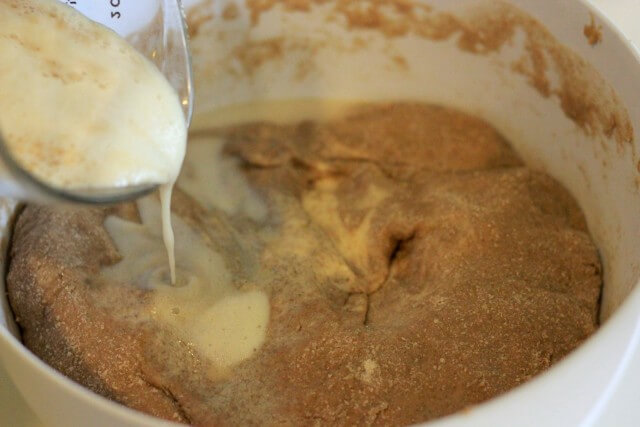
Now your dough is well mixed and back to a purty color.
Cover with that same GREASED plastic wrap, place back in your WARM OVEN and let rise for 30-45 minutes (or until doubled in size). This is only to create a warm place to rise your dough.
Look at that dough, all risen and everything.
Before we knead the dough again and form our loaves, we’re going to add 2 tsp. of salt and 1/2 crushed Vitamin C (ascorbic acid) tablet, about 250 milligrams.
Why should I add Vitamin C?
The reason I recommend adding synthetic Vitamin C to this recipe is because the goal is to make a good loaf of whole grain, soaked, sandwich bread. There are a lot of hurdles to achieving the perfection of a store-bought loaf of bread. Why? Because store-bought bread is full of soy products, emulsifiers, dough enhancers, and additives. It makes sense why their bread seems to be so perfect. It also makes sense why it’s so hard to recreate that perfection at home.
As if making homemade whole grain bread wasn’t hard enough, we’ve added the extra step of “soaking.” Which, while making it more digestible, also breaks down some of the gluten that naturally exists in wheat flour. This makes our bread even harder to stay together when making and slicing bread for sandwiches.
So, here’s the thing: If your purpose is to make a modern loaf of sandwich bread, one that you can slice easily, then I recommend adding ascorbic acid (a.k.a. the synthetic form of Vitamin C). Ascorbic acid is isolated from Vitamin C, and will not work in the same way as natural Vitamin C. Ascorbic acid is essentially a “dough conditioner.” It gives your bread better rise, a lighter taste, and a stronger texture so it doesn’t crumble to pieces.
You can still make a great loaf of bread WITHOUT synthetic Vitamin C. In fact, I’ve rocked it multiple times! However, I don’t see anything wrong with adding ascorbic acid when making sandwich bread. There are no health drawbacks with using ascorbic acid, the only concern would be for those who want to make a TRUE traditional recipe. I’m using a traditional method of preparation (aka soaking), but using some modern conveniences such as instant yeast and Vitamin C.
Obviously they didn’t have ascorbic acid in traditional societies. But then again, they didn’t have instant yeast either. When I make artisan bread, pizza, doughnuts, Navajo tacos, or anything else that requires a yeast dough, I don’t add Vitamin C. But for sandwich bread, I do.
So, back to the recipe! Like I said before, sprinkle 2 tsp. of salt and 1/2 tablet of Vitamin C to your dough.
Mix it in well.
Prepare your countertop for kneading by sprinkling a bit of arrowroot starch on a damp counter top. Why arrowroot starch instead of cornstarch? Simple. Cornstarch is GMO (genetically modified), so no thank you. Arrowroot is cheaper anyway. You can find it at your local health food store or online here.
Dump all your dough out on your dusted counter top and start kneading!
Knead your dough for about 5-7 minutes. Get it nice and tough. Remember, bread is a living thing and you really need to work your dough. Kneading builds up the gluten, so your bread will hold together when the yeast creates bubbles of gas inside.
You’ll almost want your dough to be so tough that it’s hard to roll out. This means you’ve really built up the gluten and it’ll prevent huge ‘ol bubbles in your bread. If you’re making something like pizza dough, you want those big bubbles, so you don’t need that much kneading. With sandwich bread you want little bitty bubbles. Once you’re done kneading, let your dough rest while you butter your bread pans.
Butter your 2 bread pans. I use glass. But you can use ceramic as well. They’re cheaper too.
Divide your dough in half and roll out each piece into a rectangle.
Roll that sucker on up.
All the way to the end. Tuck in the ends and sides and form your other loaf.
If your oven has cooled by now, turn it back at 350 degrees for ONLY 30 seconds. Then turn it OFF. Place your loaves in the warm oven, uncovered. Let rise for about 30-45 minutes or until the loaves double in size.
After they’ve risen, remove the loaves out of the oven and preheat your oven to 350 degrees.
Bake at 350 degrees for 30 minutes, or until the internal temperature of the bread hits 180 degrees. Click here to see the thermometer I use.
Remove and let cool in the pans for five minutes.
After 5 minutes of cooling in the pan, remove the loaves from their pans and place somewhere to cool for another 10-25 minutes. I know it’s hard. Restrain yourself! The moisture inside your loaf needs to redistribute so it won’t end up dry and crumbly.
Look at that gorgeous, light and fluffy whole wheat bread! It’s almost too pretty to eat!
Almost.
Now get to makin’ your soaked whole wheat bread! Here’s the full printable recipe…
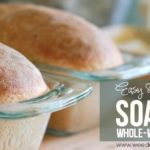
Easy & Delicious Soaked Whole Wheat Bread
Ingredients
- 7 1/2 c whole wheat flour (8 1/2 c. of whole wheat flour if your using freshly ground)
- 3 c filtered water
- 2 TBS acidic medium (apple cider vinegar, whey, yogurt, kefir, lemon) Click here to buy supplies
- 1/4 c warm water
- 2 tsp salt
- 2 heaping tsp. instant yeast
- 2 TBS unrefined cane sugar or coconut sugar
- Arrowroot starch for dusting counter top
Instructions
-
Mix flour, water, & acidic medium until well incorporated. Cover with greased plastic wrap and sit at room temperature for 12-24 hours.
-
After 12-24 hours, warm dough for 10 minutes by placing in a warm oven.
-
Mix warm water, yeast & sweetener and add to dough. Mix well by kneading with hands. Cover with greased plastic wrap and let rise in a warm oven for 30-45 minutes or until doubled.
-
After 30-45 minutes, sprinkle 2 tsp. of salt & 1/2 crushed tablet of Vitamin C and knead well with hands until the dough is tough and the gluten is well-formed. Divide dough in half and flatten out each piece into a rectangle on counter top that is dusted with arrowroot starch. Roll each loaf and tuck the ends. Butter two bread pans and place each loaf in it's pan. Place in a warm oven & let rise, uncovered, another 30-45 minutes
-
After 30-45 minutes, carefully remove risen bread out of oven and preheat the oven to 350 degrees.
-
Bake the bread at 350 degrees for 40 minutes or until internal temperature reaches 180 degrees. Remove bread and let cool in pans for 5 minutes, then remove and let cool for 10-25 minutes before cutting.
-
Devour.
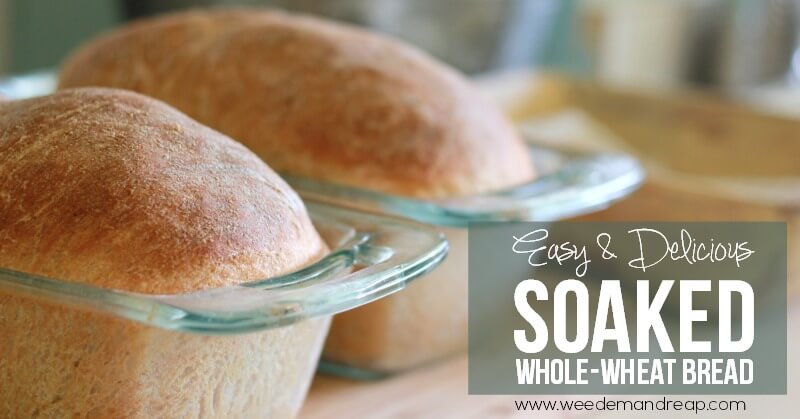
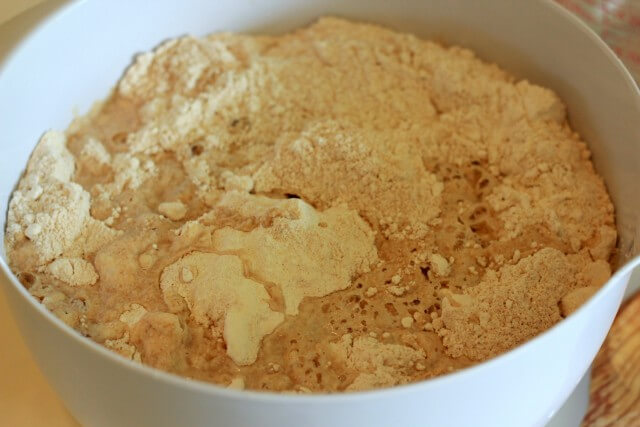
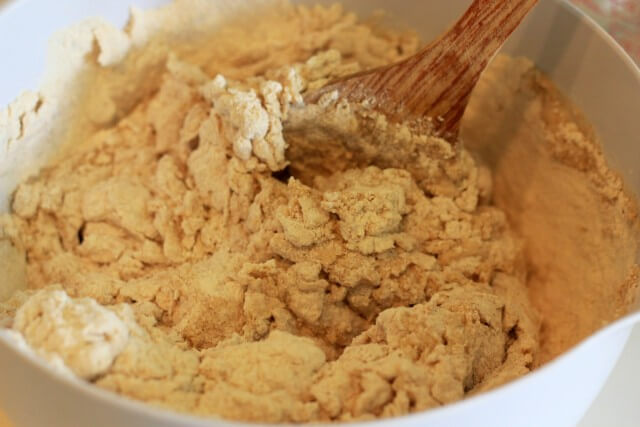
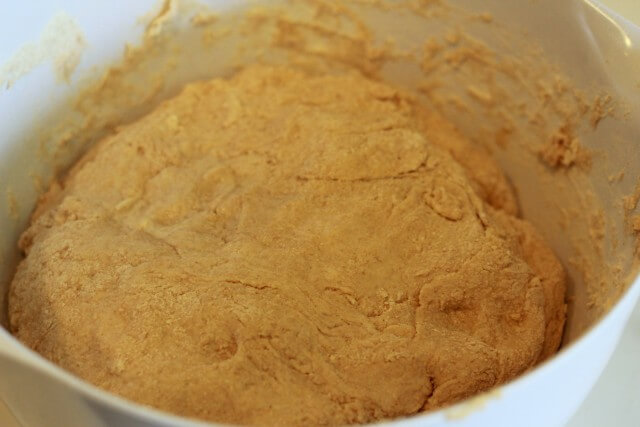
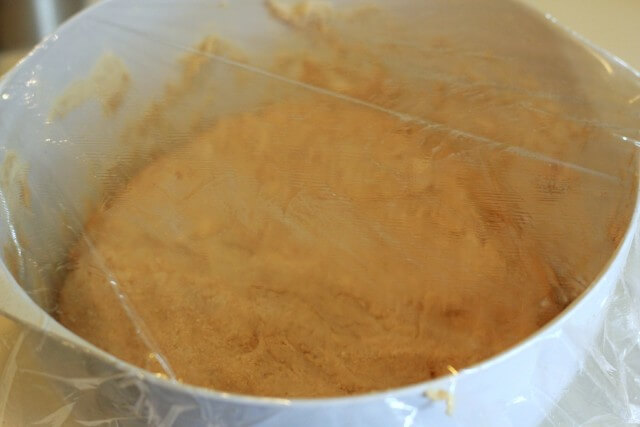
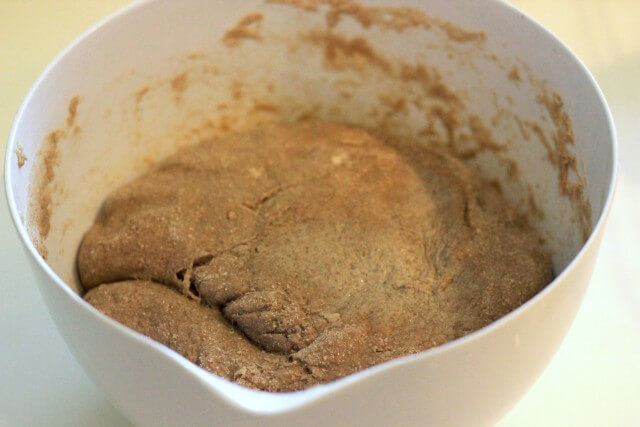
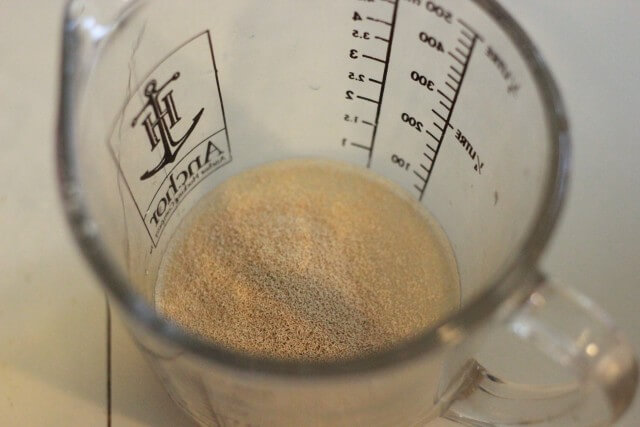
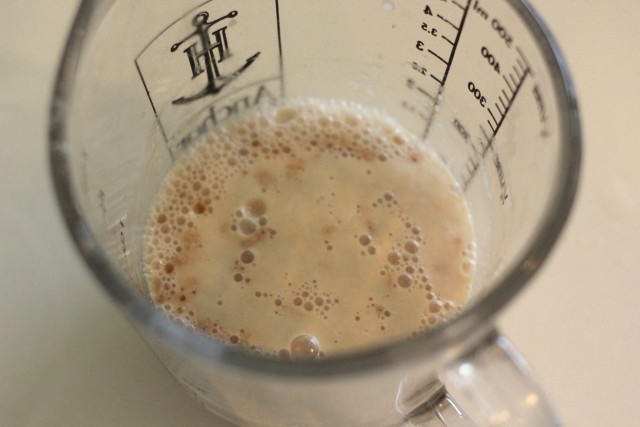
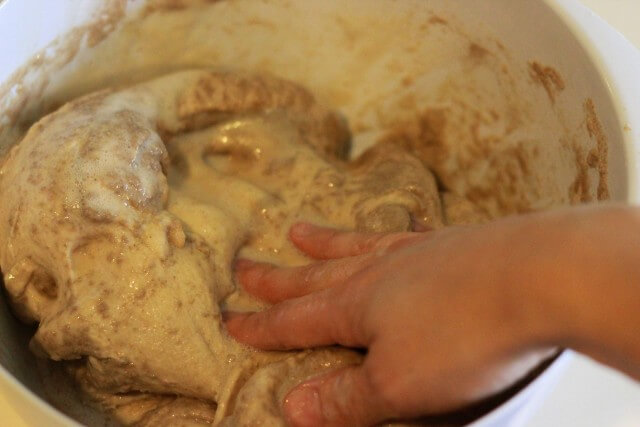
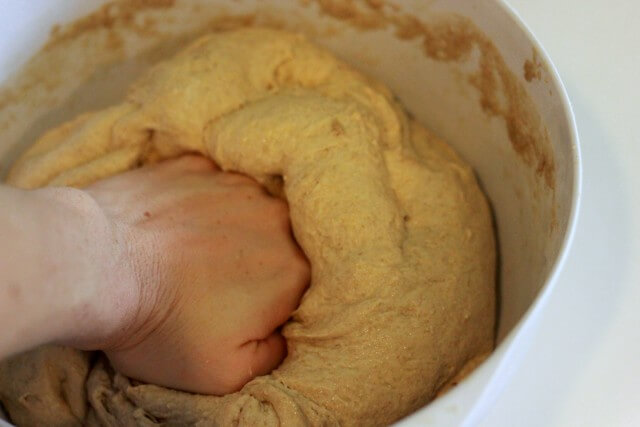
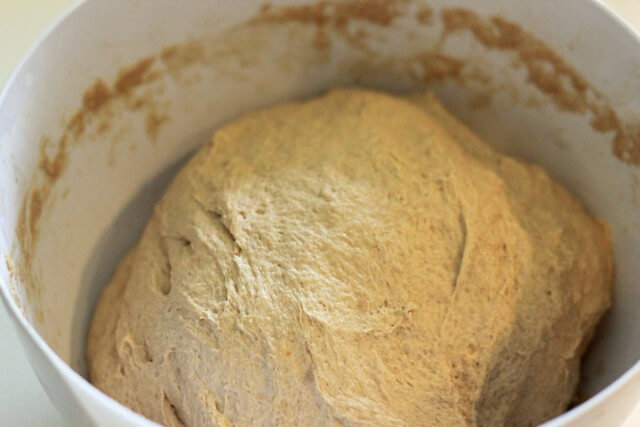
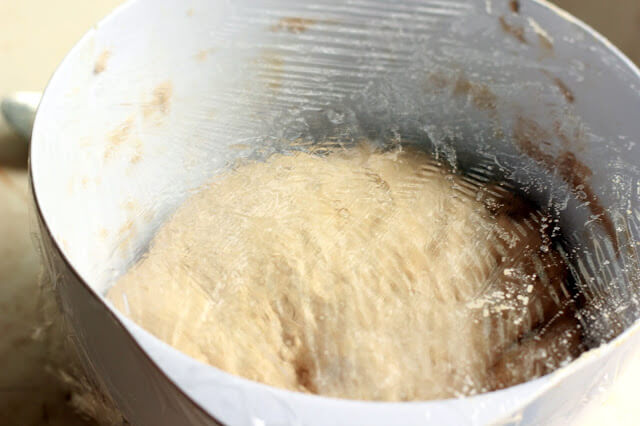
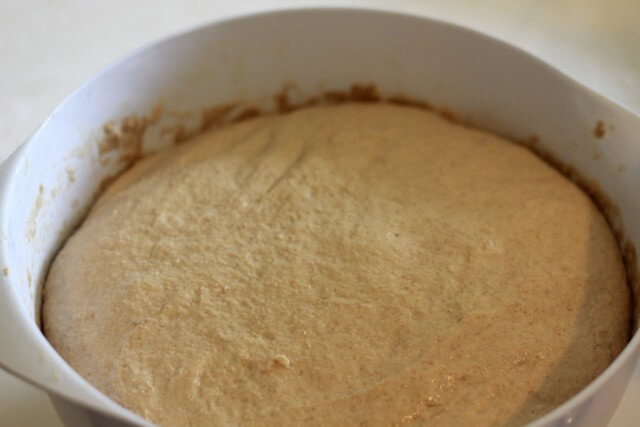
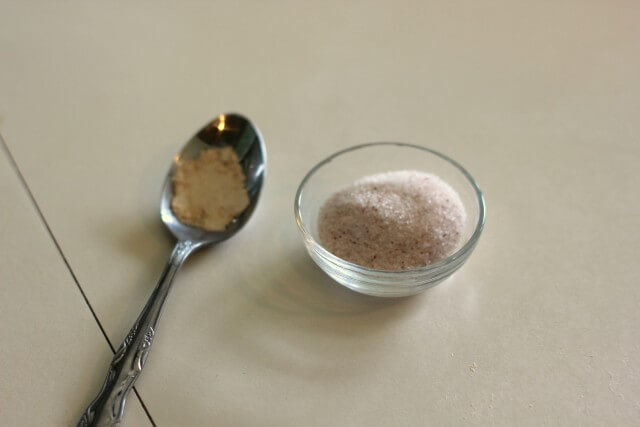
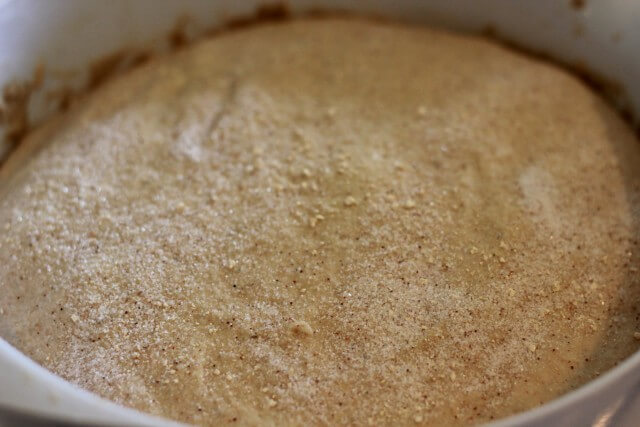
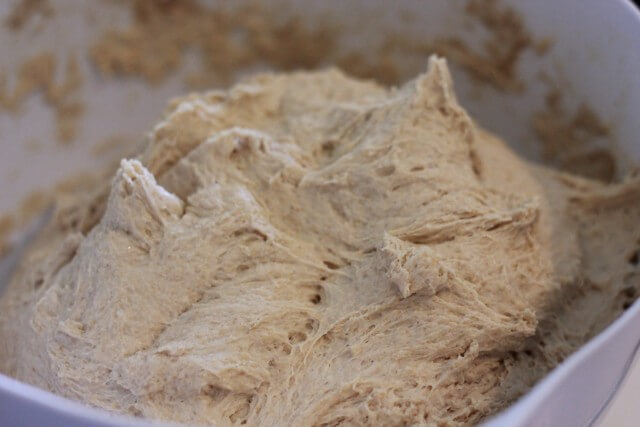
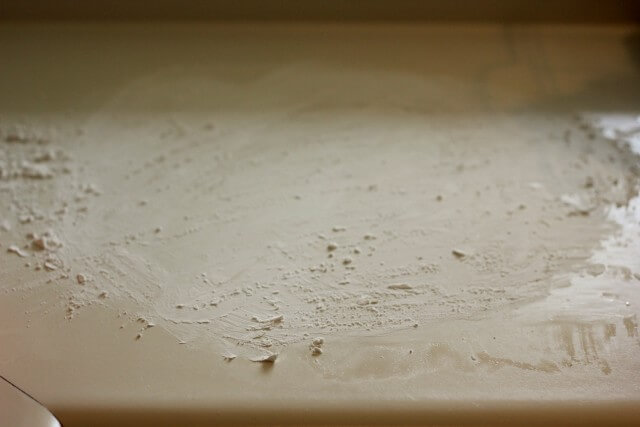
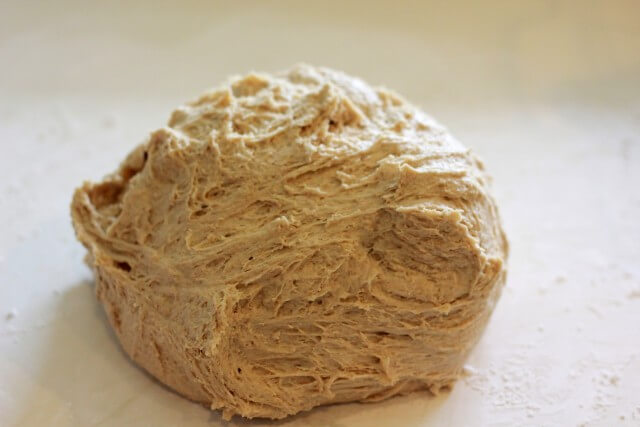
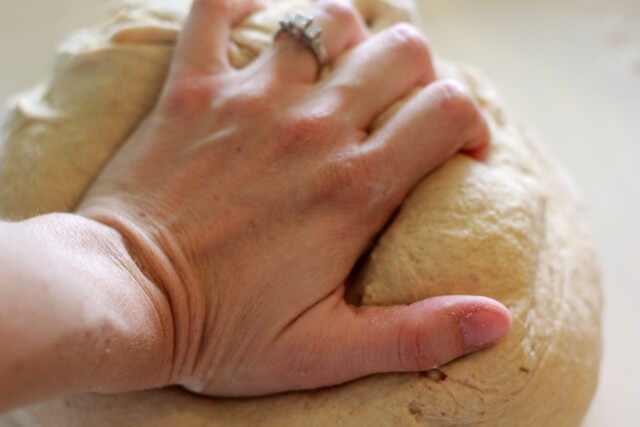
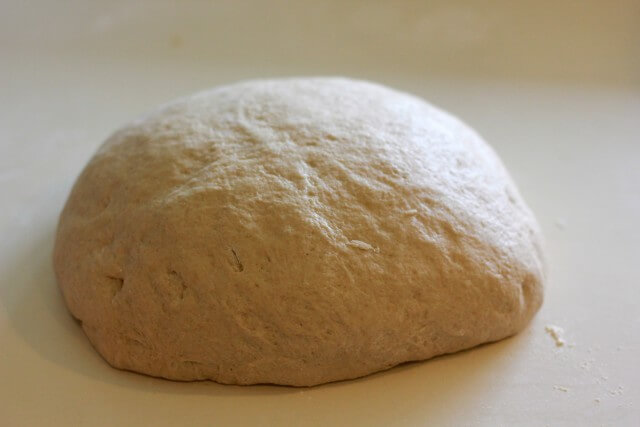
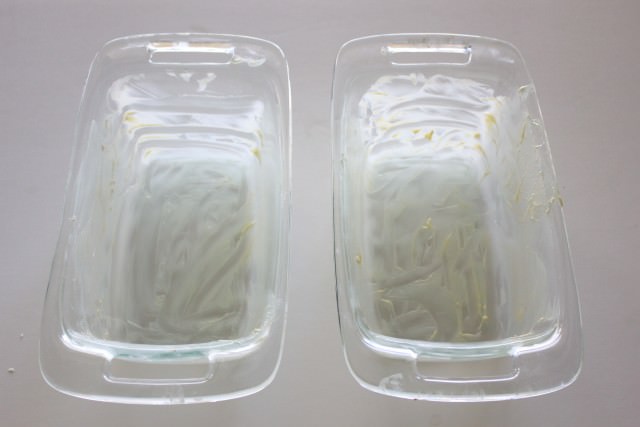
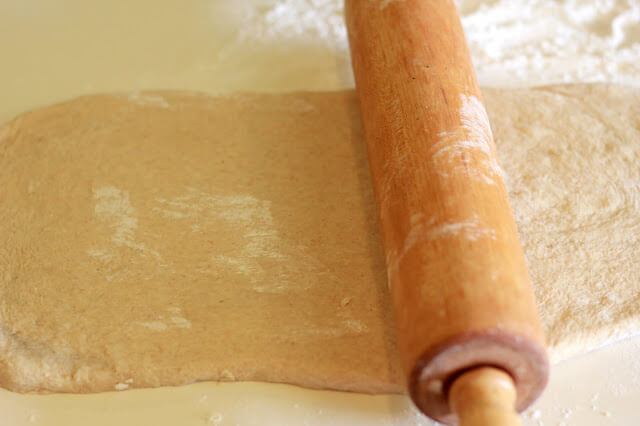
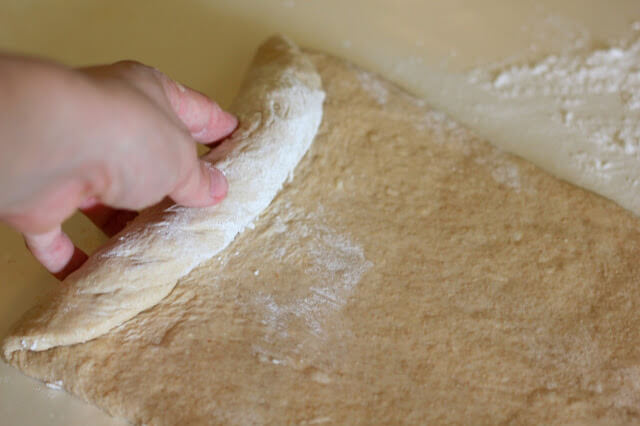
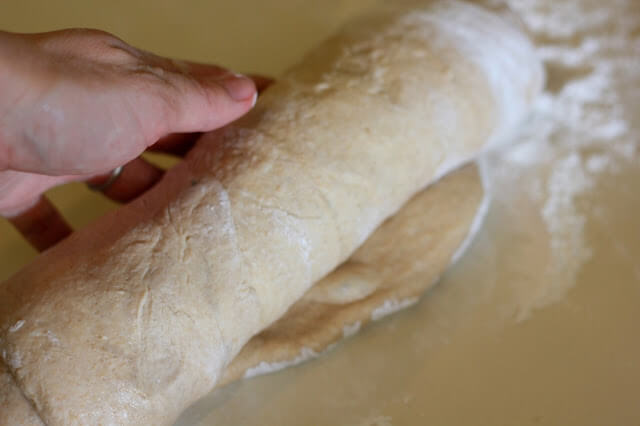
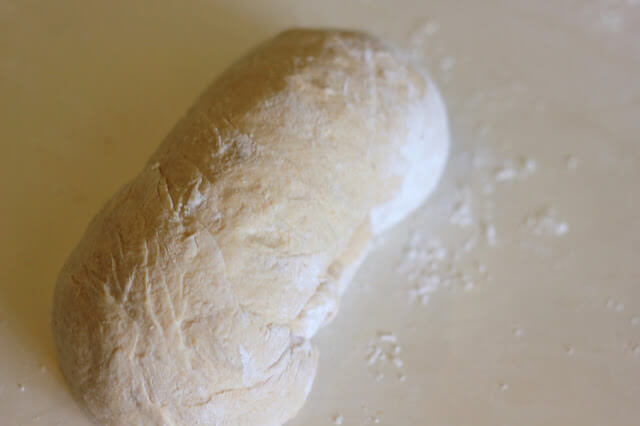
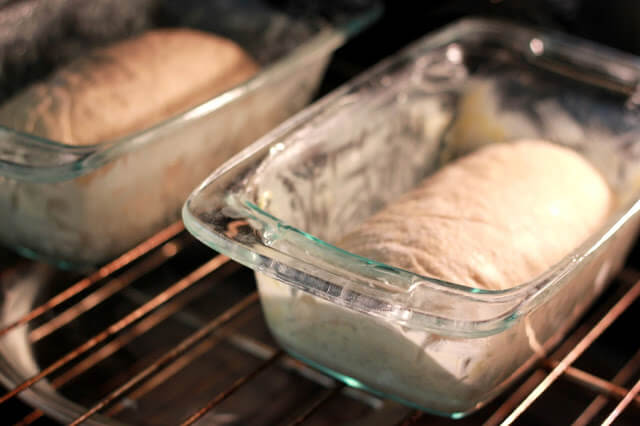
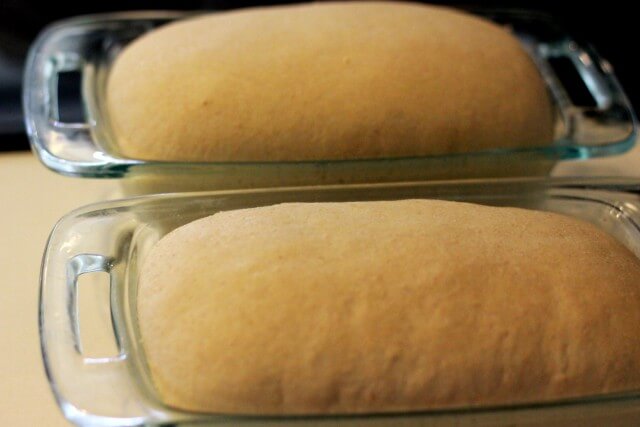
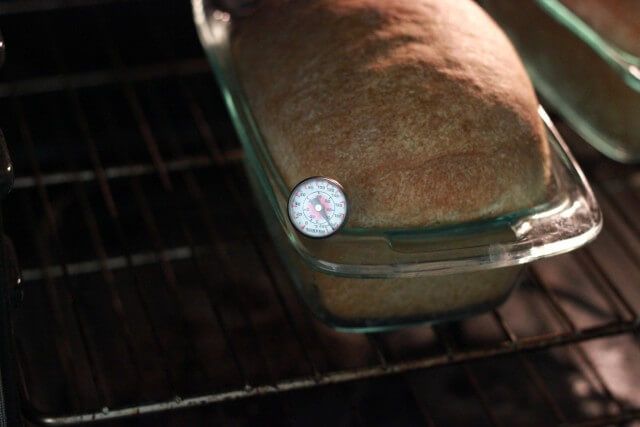
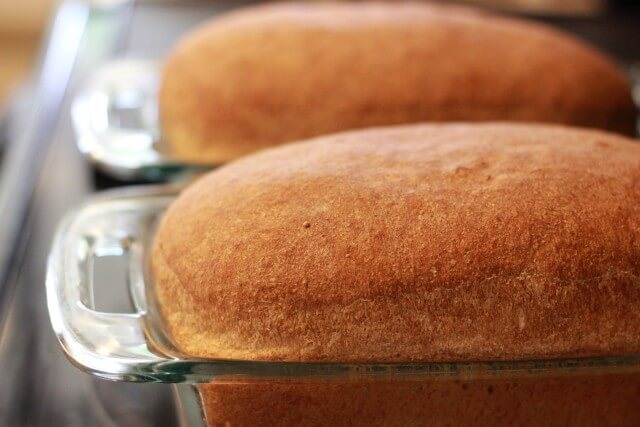
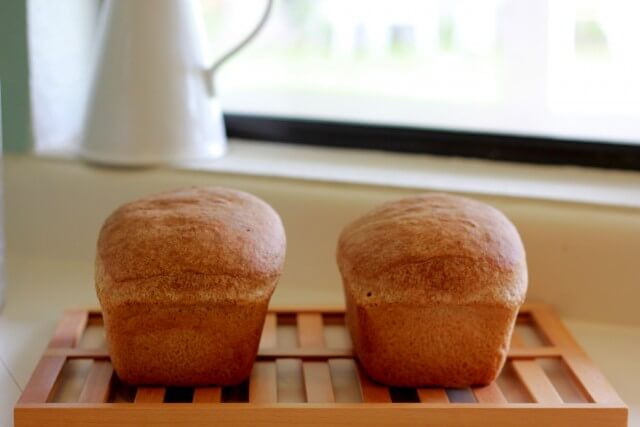
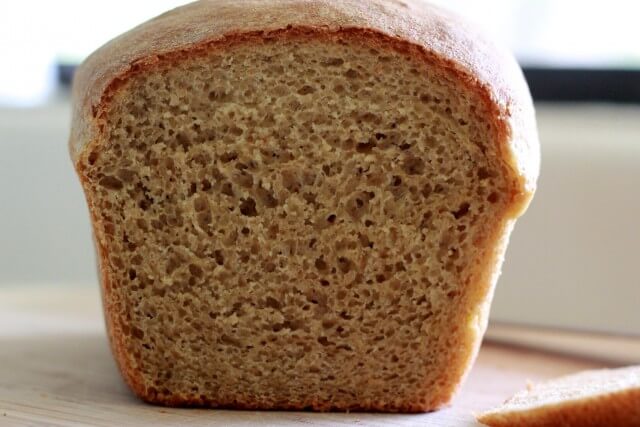
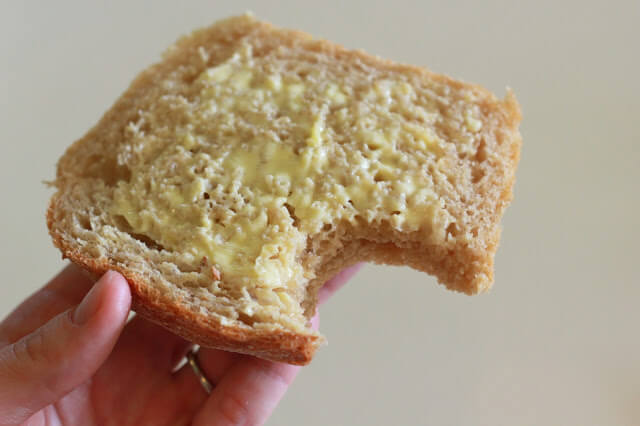
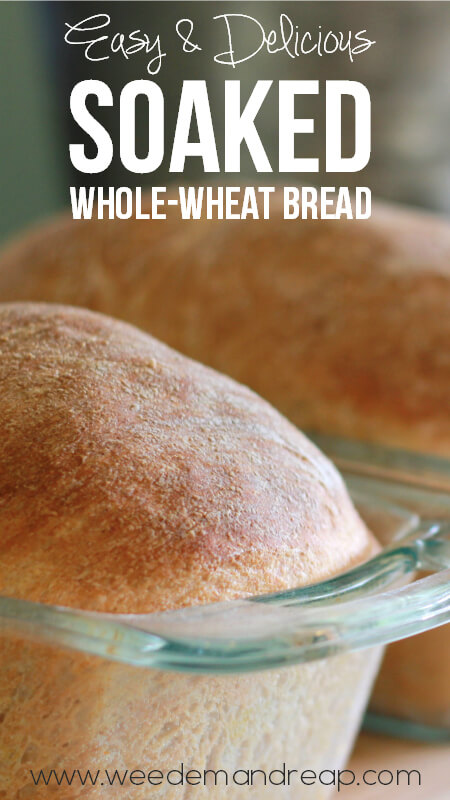
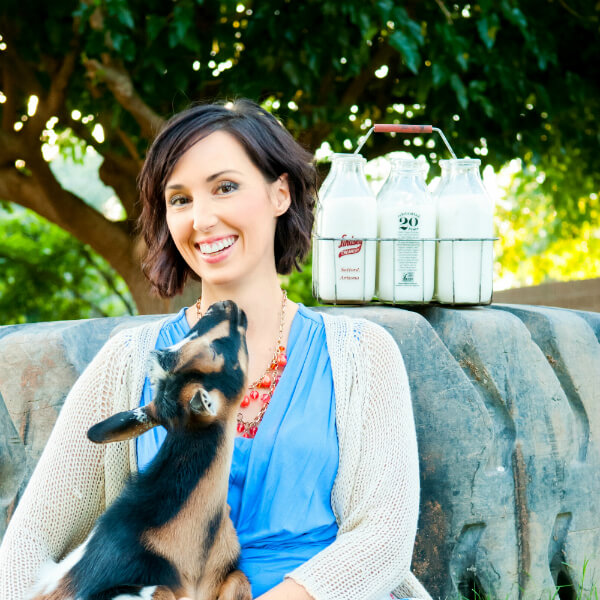
Hi Danelle,
Can I use bread flour instead of whole wheat flour for this recipe? I am not sure whether bread flour = whole wheat flour? I am in Malaysia. I usually bake bread or pizza crust using bread flour.
Hello-
Yes, you can substitute bread flour in the recipe. The texture may be a bit different and you may have to add a little more flour or liquid depending on the consistency of the ending dough.
Thank you -Bobbi (DaNelle’s Assistant)
My son is allergic to wheat, could I swap barley or rye for this recipe? Would it need any adjustments?
Hi Amanda-
Yes, you can replace it with different flours. These articles can help you with replacing them and also how to soak them if you’d like to make your own flours.
https://www.kingarthurbaking.com/blog/2020/10/05/how-to-substitute-rye-for-all-purpose-flour
https://www.kingarthurbaking.com/learn/guides/baking-with-ancient-grains
https://traditionalcookingschool.com/food-preparation/grain-cooking-chart/
Best of luck!
Thank you -Bobbi
I was skeptical to make this, but so glad I did!! It’s a little dense, but the flavor is absolutely wonderful! I used my own ground einkorn flour and had to guesstimate how much flour to add. I’m wondering if it would benefit from a bit more active yeast since this flour can be a pain to rise. Plus einkorn wheat is stickier than other types of grain and is also a pain to knead. All-in-all, I’ll DEFINITELY be making this again. Danelle, thank you for a wonderful recipe! I’m on my fourth slice as I t-y-p-e! :0)
Is there any possibility to use honey instead of sugar?
Thanks
Hi Judith-
Yes, you can use honey. If you are adding in honey there are some adjustments you need to make.
These are just guidelines and each recipe can come out a little bit differently:
-For every 1/8 cup of honey you add reduce the water by 2-3 tablespoons
-Reduce the oven temperature by 25 degrees because honey will make baked items brown faster
-For every 1/8 cup of honey you add you will need to add in 1/8 teaspoon baking soda to balance the acidity.
-A little goes a long way with these sweeteners, so do overdo it, or the taste will be off and you can also disrupt the action of the yeast
I hope that helps!
Thank you! -Bobbi (DaNelle’s Assistant)
I was wondering what brand ascorbic acid you use. I was doing some research and a lot of ascorbic acid is made from corn. I’d want to know it wasn’t gmo. What do you suggest? Do you have an option/ suggestion for skipping it in your sandwich bread recipe? Thank you! Can’t wait to try this, I’ve have many fails lately.
Hi Brittany-
C-salts has products that are corn free and non-GMO and can be found on Amazon.
You can simply omit the ascorbic acid in this recipe, however I have heard of some folks using algal proteins (i.e spirulina) to improve volume and crumb of the bread. You might give this a try. If you do, let us know how it turns out.
Thank you -Bobbi (DaNelle’s Assistant)
I absolutely love this bread! Thank you from the bottom of my heart❤️!
Question- have you tried making this dough into rolls or sweet rolls?
Hi Michelle-
You can use this recipe to make rolls. And this article has some recipes DaNelle has used and suggests, including some for sprouted quick rolls: https://www.weedemandreap.com/ultimate-guide-soaking-sprouting-sour-leavening-grains-part-3/
Here is another source for soaked recipes through the Weston A. Price Foundation: https://www.westonaprice.org/health-topics/food-features/our-daily-bread/
I hope that helps!
Thank you -Bobbi (DaNelle’s Assistant)
Have made this recipe several times over the past 2 years. Each time it turns out different. Sometimes really good…. This time I used a different whole wheat flour and the bread is too dense and gives me a stomach ache, despite following the recipe to the letter. However I notice you say to knead the dough on a counter dusted with arrowroot starch. I find this dusting of starch is not enough to keep my dough from getting gummy and sticking to the counter, so I had to add a cup and a half of white flour to be able to knead the dough. No matter my issues with my bread making ability, the bread was always delicious. But not today the bread is too dense and has too much of a bran flavour for me. I’ll have to give it away as the stomach ache is a bit severe. I have IBS and often buy authentic sourdough bread which gives me no digestion issues at all. Kind of frustrated. Maybe I’ll try making sourdough bread from scratch.
Hello, I’m changing my review. Thank you for this recipe! Today the bread is amazing! Tasty toasted or used to make a sandwich. For some reason it doesn’t bother my stomach now. Not sure what the difference is today, but I’m super happy it doesn’t bother me. So yummy! I will continue to make the bread and try increasing the flour to more cups than you suggested. At some point I’ll hit the sweet spot for being able to knead the bread without it sticking so much to my counter and hands. Thanks so much!
Oh, and would it be fine if I used active dry yeast instead? Is there an advantage to instant yeast over active dry?
Hi Pepper-
You can use either yeast, just be sure you proof the active dry yeast before using. Since you don’t have to proof the instant yeast, the process is a little bit faster and simpler.
Thank you -Bobbi (DaNelle’s Assistant)
Hi,
Was wondering if I were to use einkorn flour for this, how much liquid would I need instead? (I read somewhere that einkorn flour requires less water…?)
Hi Pepper-
Yes, Einkorn flour requires about 1/3 less of the amount water. So, if you use Einkorn reduce the water accordingly. Thanks -Bobbi (DaNelle’s Assistant)
I like to make this one at home but Im not sure if this is really that easy for me. I have not done a similar recipe before, I envy how your loaf looks perfect! Ill have this with my black bean soup.
Hi Kit-
Learning to create anything new takes time and a few practice trys. Just keep at it and it will be fine.
Best of luck and happy baking!
Thank you -Bobbi (DaNelle’s Assistant)
Do you have any books you could recommend that helped you learn about preparing grains in this original way that our ancestors did. You seem very knowledgeable about this stuff and I was wondering if you have ready any books that have been the source of some of that knowledge that you could suggest reading. Thanks!
Hi Erin-
The best book to get is Nourishing Traditions by Sally Fallon. You can find a link on DaNelle’s resource page: https://www.weedemandreap.com/resources/
Thanks! -Bobbi (DaNelle’s Assistant)
Hey DaNelle! I tried this recipe and LOVED it, but I am wondering if you’ve ever tried it with whole spelt instead of whole wheat? Just curious, as I’m trying to veer away from modern wheat. 🙂
Hi Emily-
Yep you can use spelt for this. Here are a couple other recipes to use spelt in: https://www.weedemandreap.com/spelt-pizza-success/
https://www.weedemandreap.com/spelt-thins/
I hope that helps!
Thank you -Bobbi (DaNelle’s Assistant)
Thanks so much for sharing this yummy looking recipe! Instead of mixing in two stages (soaking stage and the rest of the ingredients) can I not mix everything together, leave it to soak for 12 – 24 hours and then bake?
Hi Tosin-
No, you don’t want to let the yeast rise that long, so it’s best to do it in the two stages. I hope that helps. Happy Baking!
Thank you -Bobbi (DaNelle’s Assistant)
Do you know why it shouldn’t? I make an artisan bread recipe with a small amount of yeast and it soaks for 12 hours as well. Makes delicious bread but I’ll say not sandwich type bread.
Hi Candi-
Letting yeast rise too long can create an unpleasant, sour, or over-yeasty taste and smell. Also the bread’s structure and texture can suffer. It may be too dense, crumbly, gummy, or not get as large as a regular loaf. I hope that helps.
Thanks -Bobbi
Hi, thank you for the recipe;!Ivhad been looking for a recipe for a while as I wanted to bake a low gi loaf with sprouted flour by hrinding the wheat before soaking. This is what I did: I used about 40percent whole wheat kernels that I ground first, 30 percent Allinson whole grain flour with seeds, the rest 30 percent was a mix of almond flour, millet grains which I soaked too, soya flour, chickpea flour and ground flax seeds and a hand ful of seeds. I soaked together the seeds, the ground kernels, the other whole grain flour, The millet using the vinegar like your recipee for about 22 hours. I then added the chickpea, soya, almond flours before the first rise. The loaf rose wonderfully. It is the first time I succeed in making sprouted bread as it usually comes out mushy. Beautiful and low Glycemic give it a try!
I’m wondering if ther kneading can be done in a bread machine on manual or in a kitchen aid?
Hi Cheri-
Yes, the kneading can be done that way. Just know that if you use a bread machine for the whole process you will have to turn it off and then turn it back on when it’s done fermenting. There’s no bread machine that will allow a 6 or more hour rise. I hope that helps! Happy Baking! Thank you -Bobbi (DaNelle’s Assistant)
Thank DaNelle, I am yet to try, this recipe but am hopeful it gonna be great. I am however curious to know the shelf life. does the vinegar and Vit C help preserve the bread longer than normal. If yes how long can it last without freezing. If no what are your suggestions….
Hi niineyyey-
Homemade bread usually last about 4-5 days. Vinegar is used mostly for leavening, but may help deter mold and bacteria growth, but doesn’t extend the shelf life by much. Ascorbic acid is used mostly as a dough conditioner, but can help preserve bread. What is often used in commercially made bread, and is more effective than ascorbic acid and vinegar, is sorbic acid. You can give this a try to add a couple days to the shelf life of your bread. Double bagging your bread will also help extend the shelf life and help keep its quality intact. I hope that helps. Thank you -Bobbi (DaNelle’s Assistant)
You do all of this to make a better bread, but then you ruin it by using supermarket lab created yeast. Are you aware that the commercial yeast if lab created from chemicals? Yeah, not so healthy! Next time try using “natural yeast” aka sourdough starter and your bread will be healthy then
Hi Sarah-
DaNelle has some great articles about wild yeast starters and sourdough:
https://www.weedemandreap.com/wild-yeast-starter/
https://www.weedemandreap.com/baking-with-natural-yeast-how-to-make-sourdough-bread-un-sour/
https://www.weedemandreap.com/feeding-your-natural-yeast-starter/
https://www.weedemandreap.com/recipe-homemade-bread/
Thanks for reading and posting! -Bobbi (DaNelle’s Assistant)
If you really want to know about yeast and how it is made read this. https://redstaryeast.com/science-yeast/manufacturing-yeast/
Hi
You mentioned you don’t use your sprouted Wheat for bread? Why, would that not make it so you don’t have to soak your flour? Also could you use ascorbic acid instead of vitamin c
Hi Hank-
You can always try sprouted flour, but typically it doesn’t hold as well together and may be more crumbly. Plus there is a possibility that it may not rise as high. Besides using sprouted flour would be overkill because the phytic acid is already broken down in this recipe. Sprouted flour can be used for other things you may not be able to soak, like last minute baking.
And yes on the ascorbic acid. DaNelle talks about that in this article. Thanks for reading and posting! -Bobbi (DaNelle’s Assistant)
I bought whole wheat flour (inexpensive store brand) quite a few years ago, but never found a recipe that sounded promising – and if I hadn’t stumbled upon a white bread blog that mentioned soaking whole wheat and substituting for half the white flour, I’d have missed this wonderful recipe!
I successfully made 2 loaves, found the recipe to be forgiving (my mass produced and aged WW flour, the very cool house temp, metal bread pans, well water) and only had a couple hiccups. The first was having a very difficult time incorporating the yeast into the soaked wheat – the flour was a finer grind and it took a few minutes of kneading to start getting things together. For the second kneading, it got a LOT of kneading because when I thought I was done, looked over and saw the salt and vitC still in the dish. (The only vitC I could find had rose hips in it).
I used ghee instead of butter in the pans, which worked really well for me.
The texture is soft and slightly chewy – almost too soft to spread peanut butter and that’s amazing for a WW!!
DaNelle, thank you!
Instead of greased foil, can I use one of those clear shower caps? They have elastic which holds it snug on the bowl and they are reusable.
Also, can I use metal baking pans instead of glass or ceramic? Does it make a difference?
Hi Inge-
Yes, you could use the plastic shower caps, just be sure to grease before covering the dough.
There is a difference in cooking with metal pans versus glass or ceramic. When a recipe calls for a glass/ceramic pan/dish, but you use a metal one be sure to increase your oven temperature by 25 degrees. Also, know that metal pans are reactive and can interfere with a product when soaking and even when baking. Using a glass/ceramic pan/dish will not allow anything to leach from the pan to your food.
I hope this helps. Thanks for the questions and Happy Baking! -Bobbi (DaNelle’s Assistant)
Thanks, and also, can I replace some of the whole wheat with rye flour? How much?
Hi Inge-
Yes, you can replace some of the whole wheat with rye. To start I would do half and half. Just know that it may not rise as much and may be darker in color and have a more distinct taste. Good luck! -Bobbi
Sorry to put this here as a reply to someone else’s comment but I can’t find where to post original comment. When you talk about preheating the oven at 350, do you mean wait until it gets to 350, leave on for the instructed number of seconds, and then turn off. Or do you mean literally turn it on and as soon as it starts heating, count the seconds, then turn off?
Hi Shawn-
Great question. When I bake bread I turn the oven on, count the time, and then turn it off. Do NOT let it get to 350, count the time, and then turn it off. You want your oven at about 150 degrees to be warm enough to let your dough rise but not cook it. I hope that makes sense. If you have more questions please let us know. Good luck with your bread and Happy Baking! -Bobbi (DaNelle’s Assistant)
I turned it on, counted, turned it off but put the oven lights on – this kept the oven warm enough for the whole process until time to fully preheat.
My oven has a digital display which shows the temperature. The lowest setting is 175. It takes several minutes before it reads 150 on the way up to 175. Would you recommend waiving until it hits 150 and then turning it off?
Hi Shawna-
Yes, that should work.
Thanks -Bobbi (DaNelle’s Assistant)
I have made this bread recipe more than 5 times, and every single time it comes out super mushy and squishy in the middle. Even if we leave it in longer….
It also sinks in the middle and doesn’t rise very well at all….
Not sure what I’m doing wrong, but I followed every step except for the vitamin c. 🙁 please help. I just can’t figure this out.
It sounds like you aren’t cooking it long enough. Often times, our ovens aren’t the temperature it tells us they are, so it’s best to get a thermometer and not take the bread out until the internal temp is 180 degrees.
I tried making this bread today. I Let is set for about 20 hours. Your pictures look dry; my dough was so mushy that I could hardly do anything with it. I used half a can of cornstarch to try to knead the dough, and still too sticky! I had to scrape it off my fingers with a spoon, constantly.
I cooked both loaves until 190 degrees and the centers and bottoms was under cooked; too soft. I cooked them about 40 minutes.
I was hoping to have an easier bread to digest. I have IBS.
What can I do to make this bread edible? 7 1/2 cups of flour does seem a lot, but, must not be enough.
Flour weight and volume can vary depending on lots of factors — your humidity, elevation, how recently the wheat has been ground — so I would say to add enough flour until it isn’t sticky, even if it takes more than the recipe calls for.
Thank you, thank you for this wonderful recipe! I’ve made plenty of 100% whole wheat bread recipes in my day, and none have turned out as tasty and light as this recipe! I will be making your bread recipe on a daily basis!
*I live in the dry desert at an altitude of 5000 ft., so I cut the wheat flour down from 7.5 cups to 6.5 cups and it turned out wonderfully!
Dairy products are high in calcium, and calcium inhibits the reduction of phytic acid. Using a dairy product to soak grain in may actually remove less phytic acid than soaking in plain water! An acidic environment is good; acids help to break down phytic acid and it also inhibits bad bacteria. Why not use vitamin C as the acidic source in the soak, thereby saving yourself a step?
Instant yeast does not need to be dissolved in water like regular dried yeast. Regular yeast has an extra coating added to protect the yeast, which needs to be dissolved. Instant yeast doesn’t have a coating and can be mixed directly into the dough. Another step eliminated.
Fermentation is still more effective at reducing phytic acid than soaking. Some recipes call for mixing up the full recipe with commercial yeast and doing the first rise in the fridge overnight. Might be more effective against phytic acid than a simple soak and wouldn’t take any more time.
See https://www.functionalmedicineuniversity.com/phyticacid.pdf for a comparison of phytic acid reduction strategies.
Your pictures won’t load. I’ve tried it several times, checked my connection speed, ect. Ads load fine but none of your pictures. Thanks for the great info and the recipe.
Thanks for letting me know, we were having some technical problems there for a bit:)
Can I use emergenC drink crystals instead of asorbic acid? It’s citric acid and orange juice crystals.
No, it needs to be plain ascorbic acid.
Hi! I made the bread, it turned out really good! Not as your but really nice, moist, soft and yummy. Mine it wasn’t as high as your, don’t know why ?
I was wondering if I can add seed, such as sunflower, sesame and oats or try it whit spelt flour?
Tia
I love it
Hi Lili,
Yes, absolutely! You should be able to add all of those with success:)
I need to avoid kneading. What recipe changes should I make for batter bread?
Hi Shirley, you may want to try this method: https://breadtopia.com/sourdough-no-knead-bread/
Very delicious, considered fat free loaf..The crumb and texture are beautiful like your picutres. I soaked the ingredients, and baked in the bread machine. Thanks for the recipe.
On the vitamin C tablets, do you use the chewables? I was wondering because those are all citrus flavored and you advised against lemon juice as an acid because of the citrus flavor it imparts. I want so badly to make this recipe but the only vitamin C I have on hand is chewable tablets and I just didnt know if they would work.
I don’t use the chewables:)
I forgot and added salt at the starting itself during soaking and also a little milk powder for the taste. Will it work out
Hello-
Yes, that should work out ok. Let us know how it turns out for you.
Thank you -Bobbi (DaNelle’s Assistant)
I have sprouted whole wheat flour. Would that change the recipe ?
You can definitely try it and let us know how it goes! Sprouted flour doesn’t hold as well together (might be more crumbly) and may not rise as high.
Sprouted flour has already undergone one of the 3 ‘S’s (sprouting!) so you can make a loaf straight away without soaking! I wouldn’t bother with the extra step! I made this recipe, by the way, and it was delicious! I did find that my dough was too wet after adding the yeast mixture the second day but thankfully I had some sprouted flour on hand so I just added some of that until it was the right consistency then continued with the recipe. I love having sprouted flour on hand to use at any point without worrying about needed to soak/sour it! It is pricey though so this recipe is definitely more cost effective than a whole sprouted flour loaf.
Hi Rachael-
Thanks for the tip and info! Happy Baking! -Bobbi (DaNelle’s Assistant)
How much bread does this yield?
2 loaves.
Just curious – why is the bread uncovered whilst proving? I have always seen covered either with plastic wrap or kitchen towel to stop it drying out.
It’s just uncovered for the picture:)
The printable instructions specify to leave loaves uncovered to proof- that worked fine for me but would covering them have improved the rise at all?
Hi Jet-
If you are letting dough rise outside the oven, or in an oven that has not been heated, then you can cover it so it doesn’t dry out. However, I would not cover it if placing in a heated oven because this could either melt the plastic wrap or possibly catch a tea towel on fire. So, if placed in a warmed oven to rise, do not cover it with anything just to be safe. I hope this helps! Thanks and Happy Baking! -Bobbi (DaNelle’s Assistant)
Can I halve this recipe??? I really want to try it.
I made this bread yesterday, and it took at least twice the time to rise, and it came out a little dense, especially around the edges. Any tips or tricks to make this a little fluffier? I did add wheat gluten (2 tbsp) to my flour as I didn’t have any vit. C. The loaf has good hold and structure, it’s just a bit dense. Is it possible I kneaded it too much? Maybe I should soak longer?
Hi Heather,
If it took twice the time to rise, that would be your problem. You need a more active yeast, or a warmer place to let it rise.
Did you use regular yeast? You need instant yeast.
I’m excited to try this recipe! I’ve never heard of the asorbic acid trick, and have never had great sandwich bread success. Thanks!
Hi!
So just quick question.
For this bread can I use just store wheat flour or do I have to get a special type?
Store wheat flour is fine!
Thanks so much for the recipe. Wondering if I could do the rising of the bread in a warm area near a woodburner instead of in an oven?
Yes, I think that would work well!
Thank you so much! Just wondering: in terms of measurements you talk about cups and temperature in terms of Fahrenheit? I am from the UK. How many grams is a cup? And 350 degrees is that Fahrenheit? Thank you !!!!
Hi Tejomala,
If you google it, you’ll come up with the correct answer!
Can I use Buttermilk acid medium in this recipie?
Sure!
Hello…just a question…when I left dough out for over 14 hours, still no discoloration on top like it shows in your picture. I put an air tight lid on mine. Is it not getting enough air? Dough still looks good & moist.
I wouldn’t worry about the discoloration:) I’m sure it’s fine!
A second question even before my first one is answered!!
Actually, this is more of a comment. I think it would be helpful if you would include information about the kind of flour you use (finely ground whole wheat or a coarser, stone-ground variety) and how you measure your ingredients. Including weights would also be helpful. I have dough, made by your recipe, rising in the pans at this very moment and it is a lovely, light dough – but, at the kneading stage, it was too sticky to handle so I ended up kneading in a bit of white flour. My WW flour was a coarse, stone-ground variety and I measured it by spooning it into the cup and the leveling and both of those could account for the sticky dough. I’ve always got 1/4 to 1/2 ounce more flour in a cup if I simply scoop rather than spooning the flour into the cup. (I gave the dough an additional short rise after kneading in the white flour before I formed it into loaves. I had hoped to make round, artisan loaves using an oven stone but the dough was much too soft for that.) Looking forward to the finished bread. David
I like the simplicity of your recipe . . . and have some whole wheat soaking at this very moment. I’m curious, however, why there is no fat in your recipe. What are your thoughts on fats in whole wheat bread? Even in my sourdough whole wheat I add a tiny bit of fat believing that it adds a bit of tenderness to the crumb and extends shelf life. Thanks. . . David
That’s actually fine, fats do well in breads it’s just that this recipe doesn’t call for it, except for greasing the pans:)
Hi, I just came across this recipe, and would like to use it to make rolls. Are there any adaptations you would recommend? Thanks! BTW, am having fun checking out your site. Great stuff!
It shouldn’t need any more adaptations, it should be yummy! Good luck!
What type of wheat berries do you use for bread? Hard white or hard red or something different? I’ve not had the best luck in the bread making department lately– too dense, dry, and seems to crumble once you get to the center pieces if cut too thin. Any suggestions on what I could be doing wrong? TIA!
Hi Leah! I use hard white wheat berries:)
Have made this delicious bread twice. Thanks for your great instructions! I’m curious why you roll the dough. I’ve followed your rolling directions and my loaves always come out lopsided with a crack down one side the length of the loaf. Next time I won’t roll and see if it makes a difference. Thanks again for the great recipe! 🙂
Hi Christine,
Sometimes that does happen if you use too much arrowroot starch when rolling out. Definitely see if another method works for you, though!
Okay, that makes sense. The dough was extremely sticky when I made it so I will increase the amount of flour I use in the soak. Thanks so much! Appreciate your support.
I didn’t roll mine out, just divided dough, roughly shaped into a fat rectangle with my hands and rolled it up
I just made this and the loaves came out perfectly and are so delicious! I did needed to double the rising times for my house and oven environment. Thank you for the recipe. The pictures along the way of each step were really helpful. I knew I was on track! I am going to make loaves for Christmas gifts!
🙂
Awesome, Liz!
Came out absolutely perfect! Thanks for this recipe.
Hello! Do you know if this is THM friendly? And does the soaking act the same as when you would sour the flour in the fridge for a week? I’m wonderingly if the soaking helps break down the carbs like it does when it sours. I’m a type 1 diabetic so am always looking for recipes that won’t reek havoc on my blood sugars. Thanks so much!
That’s a great question, and honestly, I’m not sure about it. Sorry, I wish I could be more help! For homemade things like this, you may have to try a bit and watch your blood sugar levels
Ok…so, they rose a little bit in the loaf pan then promptly fell and are useless unedible failures.
Everything looked right and felt right until the mixing in of thd yeast. It rose nicely the first time and disappointed me after that.
I’ll try again…
I haven’t made a good loaf since moving to Oklahoma last August. I’m at my wits end. I’ve tried sour dough, my usual memorized recipe from Bread Beckers, this and all have failed…what am I doing wrong.
I made bread in Illinois for years without trouble.
Sad baker…
Hi, thanks for the recipe.
My first soaked loaves are in the oven rising right now.
My problem is that they are soooo wet and sticky. The dough stuck to the bowl and my fingers. There was no rolling option for this dough. I used more about 8 c of freshly milled flour.
Question : is the yeast water mixture supposed to be runny?
We’ll see how they turn out.
Hi Katrina,
When you use freshly milled flour, there is a lot of air mixed in and as a result, you probably only really used 4 c. of flour. Next time, try adding until it reaches a very thick dough consistency. Let me know how it goes!
Hi
I live in the MiddleEast, and it’s veryyyyy hot and humid over here at the moment. Is it okay to keep the soaked dough on the kitchen counter in this type of weather? I would appreciate your reply.
I just soaked my whole wheat, I’m trying to make whole wheat tortillas.. 🙂
Thanks!
Hi Hadia,
I would, but I would soak it for a shorter duration.
Hi
I tried this bread today. Soaked it yesterday. But today after I mixed the yeast its really wet and sticky even though I did add a little extra flour yesterday as well as today. The wheat that I usedwas ground about a fortnight back. Is that still considered freshly ground? And I did halve the recipe….
Can I add more flour after I have added the yeast?
Yes, you can add more flour afterwards. In the future, just try to add more flour in the beginning:)
Thank you so much for this detailed recipe…….my family loves it!!!!
You’re welcome Beth!
Hi, Thank you so much for this recipe. I love making bread did not know why, and have been wondering about the amount of liquid the wheat needs. Something told me to soak the wheat. I was delighted to see your recipe but have done it differently because I wanted to REALLY soak the wheat. Therefore, I use half whole wheat and half strong bread flour. I used all the water with half of the flour and left it to soak for about 18 hours. Then I added the yeast, water and honey. Then after rising, and adding the salt and Vit C, I started to knead it really well with my mixer adding the extra flour bit by bit. When it cleaned the bowl, I proceeded exactly as you did. AND the result – superb – first time I have ever had such well risen wholemeal bread and it is delicious. Thank you for the heads up. I had been trying to work it out myself but did not know about the soaking overnight or the addition of the acid medium. THANKS.
Oh that makes me so happy Vivian! I’m so glad it works for you!
My dough is currently soaking on my counter while I am at work! Can’t wait to taste the finished product! I am new to your website and I am loving it! I have been obsessed with getting a goat for sometime and my husband is totally for it! So glad I found your site!
Haha, I love that you want a goat! And kudos to your husband for being cool with it!
Can you give the flour and water quantities in ounces? or grams?
Sorry Caren, I don’t have the quantities in ounces or grams:)
I’ve made this bread several times, and while I love the taste, it seems like no matter what I do I get a very heavy and dense loaf of bread. It doesn’t really bother me, I’m just curious as to why this is happening considering this recipe suggests it’s supposed to be “light and fluffy”.
You might be adding too much flour, or you could be using old flour. I’d also try to let it rise longer and be sure to use an internal thermometer to make sure the bread is done. (needs to be 180 degrees internally)
Can you sub raw milk for the second addition of water? Do you think it would change the recipe much?
I think you could totally do that!
I have been making bread with einkorn flour. I finally got it down and it works great. I decided to purchase a flour mill and milled my own einkorn flour. After sifting it, it seems like good flour. But every time I make it using my normal recipe, it makes wet dough. As I don’t want a brick, I bake it that way, without much rise and no oven spring. But, the bread is good and light and not dense. But I am looking forward to making this bread to see if it will work. I really enjoyed the article…great sense of humor, great pics. (Please work, please work, please….work). Thank you!
You didn’t answer my last question so I used Camu-Camu for Vit.C. It turned out beautiful and it was my very first time baking bread w/out the machine. Beginners luck maybe? I want to do this again but have it ready to eat in the morning w/out getting up at 5 am. I have read you can put it in the fridge after it has risen and bake in the morning. My question is, would you know until which step I can go before putting it in the fridge? Could I go as far as the last step, take them out(let the pyrex warm up frist off course) and bake them? I hope you answer soon…
I’ve never done that, but you could definitely try it and let us know how it works!
I LOVE this recipe, I baked it several times now. With Vit.C is the best. Athough Camu is suppose to be high in vit.c it doesn’t work the same. As far as waiting to bake it works the same but I find it takes longer than 30 minutes, I usually lower the temp after 30 minutes and keep baking up to an hour so it doesn’t really work to try to have it ready for breakfast. We just heat it up.
You did not list vitamin C in the ingredients, what kind of Vit.C do you use?
I just used one from my health food store. Nothing special:)
Thank you! This is the first time I’ve been able to make bread that has actually risen properly! I’m very excited about this recipe
Quick question – the printable recipe says to bake for 40 minutes, while the step-by-step tutorial says 30. Which is correct? (Although I will have an answer in about 22 minutes since my first loaves are in the oven!)
Thanks for a great tutorial for a bread making newbie!
It’s about 30-40 depending on how brown you want it:)
Loved your asking the time cooking needed when you had it in the oven already and had 22 minutes left to bake, gave me a chuckle.
Can’t wait to try this recipe! Thanks for sharing!
Hi, I am wondering what the best way to store this bread is? Thank you!
Have you tried this recipe with freshly ground Einkorn, by chance? If so, does it take the same amount of liquid?
Hi Kirk,
I haven’t tried it with Einkorn yet, but I’m going to get a big bag of it and so I’ll definitely try it!
Hello! Did you ever try this recipe with einkorn? How did it work out? Thanks
I still haven’t yet!
Hi do you think I can substitute half of the flour with all purpose? Also would it be okay to add some raisins to this? I really want to try this recipe out !
Go for it!
If I want to add seeds and nuts, do I soak them too or add them after the 12 hour soak?
It’s totally up to you! I’ve done it both ways:)
So, I made this over the weekend and it worked out really well. I was short on whole wheat flour, so I used about 2 c whole wheat flour, 3 c graham wheat flour & 2.5 c teff flour and YUMMO! It was a home run. I’ll be trying this next time and adding poppy seed, millet, raw sunflower seeds, and whatever other seeds I have around. Yum Yum. Thanks for the recipe!
Can I use the soaking method for any traditional bread receipes ahead of time?
Sometimes it’s tricky to adjust a family recipe, but you can give it a try!
After soaking my whole wheat flour, water and ACV overnight for at least 16 hours, I opened it to put in the warm oven and noticed it was very moist – not like your pictures. Is it too late to add maybe some potato or rice flour to it when I knead in the salt and Vit C? I don’t want to use normal flour as I’m sensitive to unsoaked wheat. (Well, actually this is the first time I will eat wheat in a very long time.)
Great bread! I did not use vitamin c and I kneaded with olive oil instead of arrowroot powder. Grew up baking bread for my parents bakery…I never knew that cutting the bread while hot would dry it out! It makes so much sense though! Thank you for the great recipe! I am trying it replacing 1 cup water with 1 cup of yogurt (I ran out of vinegar). I’ll see if it works!
I made this last weekend, and have another batch in the oven now because both loaves are already gone! I didn’t have any problems with sinking and although the dough was sticky once I put yeast in, the problem seemed to correct itself after the first rise and especially when I was rolling it out (must have been the arrowroot). The texture was amazing, light and fluffy, easy to cut, just perfect. The taste was a bit bland however, and it turns out I only added half the salt by accident. Oops! I made sure to add in all of it this time around, so we’ll see how it goes! I was nervous about working with yeast, but this recipe was super easy and turned out great! My dough had to rise an extra half hour, but that wasn’t a problem. Thank you so much for sharing!
So glad to hear it worked for you!
What are the sizes of your loaf pans? 3×7? 4×8? 5×9? I have them all so when it says put into a loaf pan in a recipe I always get confused 🙂 Thanks
I use all sorts of sizes, I’m not that particular about it, any size works!
I made this bread over the weekend and I Love It!!!! It turned out fantastic. I have had so many bread fails that I was concerned, but it worked beautifully. Thank you so much for the great recipe.
Oh, I’m SO glad Carol!
I do know for me it makes a difference in what type of wheat I use. For several years now I have tried working with hard white wheat but my bread just falls flat or it takes so much more flour to get a thick dough. So now I only use hard white. For this recipe, I grind up and just measure out 8.5 cups of freshly ground hard red wheat and add the 3 cups of water with ACV. Sometimes I have to add more flour to get that thick dough I know I need to keep the bread from falling but never less than 8.5 cups.
So far my favorite bread recipe has been Peter Reinhart’s soaked bread, but this looks simpler and I definitely am willing to try adding the ascorbic acid. I have found that I love recipes that give weight amounts, especially for something difficult to measure in volume like flour. Would it be possible to get the flour amount in ounces instead of cups?
Sorry Denise, not right now, but I’ll definitely try next time I make it!
Finally got around to trying this and it turned out beautifully. I only made a half batch to try first but I will certainly make a full batch next time. I have never had a homemade bread rise so well! It was popping out of the pan before I even started baking it. The crust has a nice chew but it is soft enough for a sandwich. I may try adding some butter next time as well.
That is so good to hear,thank you Karen L!!
I saw this on Pinterest,really excited to try it! I have one question,do these loaves freeze well?
I love your blog BTW. My husband and I have been talking goats for a year. I think he’s almost ready to take the plunge ;).
I make two loaves using this recipe every week. I cut each loaf in half, keep one in the kitchen and freeze the rest. They do great in the freezer.
Yes, they freeze very well!
Have you ever doubled or tripled this recipe? Looks amazing! I’m searching for a great soaked whole wheat recipe that can do several loaves at once. 🙂
Yes, absolutely you can!
I’ve made this recipe using apple cider vinegar quite a few times with beautiful results every time. I recently decided to try using kefir whey instead. The end result was even more sour than sourdough bread. I couldn’t eat it. Any ideas on what went wrong?
It really depends on how much kefir you used. If you used more than the 3 TBS., I could see it turning out pretty sour:)
I was so excited to get and read your book and happily begin eating grains (ie REAL food) again. I have made this bread (or a similar method) for quite a few years for the family but don’t generally eat it (one MUST test a fresh slice, right?). So imagine my surprise when, the morning after eating two slices, my fasting blood sugar was 120! I’m so sad to take grains back out of my diet…..(and I have two fresh loaves cooling on the counter right now…)
Hi Karen,
Did you eat anything else with the bread? I’m curious to see what your blood sugar would be after eating it with protein.
Great article. Thank you for writing it.
Just wondering about GMO cornstarch. Is it only North American made cornstarch that is GMO? If I found cornstarch made and packaged in the EU, or other countries, is it possible it isn’t GMO?
Yep, if it’s out of the US, it’s most likely non-GMO:)
We have just started trying to eat clean, and this recipe was great! My kids are super picky and have never liked whole wheat bread from the store. They ALL liked this – minor miracle in my book! And I made your soaked tortillas tonight, and they were a hit as well. We are finding that eating clean foods really does fill you up, and we are excited about this journey! One question – do you think I could bake one loaf and leave the rest of the dough in the fridge similar to the artisan bread in 5 minutes a day method? Right now, I think the second loaf is going to go bad before we can enjoy it.
I make up both loaves and then cut each loaf in half (only two people eat it) and leave one half out and freeze the other three halves.
Thanks, Karen, I’ll give that a try and see how we like it! It would be nice to be able to pull out a fresh loaf from the freezer when we need it!
Awesome! Sure, I think you could use the dough in the artisan bread recipe:)
So I just made this and it turned out pretty good! I should have let it rise a little more in the pan but overall it was great! Since I didn’t have any vitamin C pills, I added in a TBSP of apple cider vinegar when I was mixing the yeast in as Lauren {artisan bread maker comment} suggested. Also added a bit of coconut oil just because I could.
As for the warm oven issue, I followed one of my America’s Test Kitchen recipes that recommends you set your oven to 200 degrees and once it reaches that temperature, leave it for 10 minutes and then turn it off. That worked fine and I didn’t have to worry about if I was doing the 350 degree thing right or not.
I only made a half recipe and am looking forward to trying again and doing a better job next time. Thanks!
I used this recipe today. It is fantastic! My son, who normally experiences heartburn after eating homemade whole wheat bread, had no problems at all eating this bread. My family loves this recipe. It’s a keeper, for sure. Thank you for sharing this!
Oh, that makes me so happy! I’m so glad you like it!
Yes, it does nicely in the freezer. I make two loaves weekly. I cut each loaf in half, keep one half out then freeze the other three halves individually in freezer bags.
Can the bread be frozen after baking? looks like an awesome recipe to try! Thanks so much!!
You only let the oven heat for 45 seconds…
Just to provide a warm place for it to rise. For baking, I let it fully preheat:)
Hi! I’m excited to try your recipe, but I’m confused on one issue: the heating of the oven. 🙂 Do you heat the oven all the way to 350, time 45 seconds and then turn it on? or do you push bake (mine is set automatically to 350) and after 45 seconds turn it off? Thanks for answering my question!
Nope, I just let it *start* to preheat to provide a warm place for the bread. You don’t want a hot oven, just a warm one:)
Hey Molly – take a good look at the photos (and links) DaNelle shares above. I have found my bread to be most successful when I’m using hard red wheat (I grind my own) and to make my initial dough really thick/stiff.
Also, on the yeast, she gives the link to the yeast she uses: it is Saf Instant. The thing about that yeast, however, is that it doesn’t have to be proofed; you can just add it to your dough, which is what I do (I use the same yeast). I shared my method/recipe above (not too far up from this). I make it every week. 🙂
Thanks for helping Karen!
I’m not sure if you are still following comments, but I had some questions. I would up with a very wet and sloppy dough. Too sloppy to work with at all. Almost a heavy batter. What method did you use to measure your flour? I was using Hodgeson Mill Stone Ground Whole Wheat, which should work. Also, can you clarify if you used instant or active dry yeast? The recipe says instant, and I have active dry so I doubled the yeast as you should when subbing, but I wound up with way too much yeast, bread batter boiling out of the loaf pans and a mess in my moms oven. So embarassing! Hopefully you can let me know. I would welcome any pointers. I can make a gorgeous loaf of white artisan bread, but wheat bread is a total fail for me and I am really hoping this recipe will be The One to save me from my whole wheat failure.
Hi Molly,
Yes, in the beginning mixing period, make sure that the dough is nice and tough, less like a batter and more like taffy. Sometimes when you make bread you have to add a little more flour depending on the humidity and the altitude where you live. If you start out with that, you should be goo!
And just like Karen said below, use the Saf instant yeast. You don’t have to proof it, but you can do it if you want!
Just tried this, thanks… it turned out perfect!
Love this post – great photo tutorial! However, I was under the impression that using fast-rise yeast is not healthy, so is this as healthy as your other post on making sourdough bread? I mean, is the phytic acid broken down to the same degree in both of them?
This is my first soaked loaf ever! I just mixed the ACV, flour, and water and set it up to soak. I’m really excited. I think I’m going to add some butter like other people mentioned, and I halved the recipe just in case I manage to mess something up this time. 🙂
I have read that a lot of synthetic vitamin C is often made from corn, which if not organic is probably gmo…. just in case you wanted to know.
If I only have one loaf pan and only want to make one loaf at a time should I halve the recipe or keep half the dough in the fridge for a few days until I want to bake another loaf? If I did refrigerate it what would I need to do before baking it?
I made this recipe and it turned out perfect! My husband and kids loved it. Thank you for introducing me to soaked grain products.
Thanks!
Can I use my souredraw milk in place of the water?
If you mean buttermilk, then yes:)
After looking at another recipe that I’ve used, I decided that 8.5 c of flour (as this recipe calls for) would make more than two 8×4 pans, so I cut the recipe back accordingly (in my mind). Then I realized that the reduced recipe looked a lot like a recipe I’d been using until I tried my hand at sourdough starter. So I combined the two and had terrific results!
To get two (2) 8×4 loaves, I did this:
2 cups filtered water, room temp
5-6 cups freshly milled flour (or however much to get the thick dough we’re after)
2 Tbsp apple cider vinegar (I use Bragg’s)
2 tsp instant yeast (I’m using SAF so my instructions are for that)
2-3 Tbsp sugar (organic, unrefined…whatever)
4-6 Tbsp unsalted softened butter
2 tsp sea salt (or more!)
I did pretty much what DaNelle said to do: I combined the water, flour and ACV to get a very thick dough the night before. Since I’m using the same yeast she is (SAF instant), I read the pkg and it says you can add it directly to the dough. So after the 12-hour soak and warming in the oven, I added the yeast directly to the dough and worked it in.
I like fat in mine and someone above mentioned that yeast needs sugar; I usually use honey but didn’t want to mess with the hydration and just used the sugar I had on hand (don’t ask!). So I added in the 3-4 Tbsp soft butter and 3 Tbsp sugar along with the yeast and then followed the recipe per DaNelle’s instructions.
I noted the SAF yeast has the ascorbic acid in it so I opted not to add additional Vit C.
I followed the rest of the directions (using my hands to mix and to press the dough in to a rectangle for rolling) and I was very very successful! I was scared when I picked up the cooled loaf; it was so light! Since it had risen nicely, I was scared there would be big holes in it. But there was not! Super light, super fluffy and very tasty!
I might be asking the obvious…but what size pans are you using?
I use 8×4 pans but it seems like the amount of flour in this recipe will call for the larger 9×5 pans.
I’m excited to try this recipe!
I’m using the 8×4 pans too:)
If you had a dehydrator, can you rise the bread in there? What would the temperature equivalent be?
hi,
i have a few questions:
1) what is the difference between “active dry yeast” and “instant yeast”? my bread hasn’t risen the last time i used dry yeast .. i’ve probably done it wrong somehow ^^”
2) could i use a “wet/live yeast cube”? (idk what’s that called in english^^” here in germany you can buy those yeast cubes which weigh 42g = ca. 1.5oz)
3) how much vitamin c powder do you get from half a tablet in teaspoons?
great and easy recipe btw =) i will try it, after i found the right yeast^^
thanks in advance!
My bread recipe calls for additional 1 cup of wheat germ for extra nutrients. Should I soak the wheat germ along with the flour, or not? The flour calls for about 7 cups.
Thanks!
I’ve never considered myself a baker, but your recipe is so easy! I’ve made this bread twice now and both times it was a homerun! For the Vitamin C, I use my grand-daughter’s leftover Acerola powder from her WAP homemade formula recipe. I researched it and found it to be an acceptable dough conditioner. I just use 1/8 of a teaspoon. Thanks!
Just to make sure I understand, if making bread in my bread machine, do I just follow my recipe in the book that came with it? Like if it calls for 4 cups of flour, soak that for 12 hours then follow the recipe from there? I’ve only made bread in my bread machine.
Ascorbic acid is not good for you. Please check out this video: https://herbdocblog.com/winter-launch-video/ Most ascorbic acid comes from China. It is made with GMO, then acetone(nail polish remover) and bleach. Dr. Shulze calls it Vitamin Chemotherapy because of the damage it does to your cells. Please check out the video because he explains it a lot better than I can.
Vitamin C is the number one most important vitamin in human nutrition. Most animals make their own, but the great apes, fruit bat, guinea pigs and humans do not and must get it from food. Dogs alone make about 40mg/Kg of body weight. that means my little 10lb mini doxie makes a little under 200mg per day, and a big 100lb German shepherd makes a little under 2,000mg per day. Every day. We can’t even get enough from food any more due to the SAD USA diet.
Please check out Linus Pauling’s books, particularly ‘Vitamin C, The Common cold and the Flu’ and ‘How to Live Longer and Feel Better.’ There are no GMOs left in the final product, even if it starts with them, it is a single pure molecule, not a mixture of anything. Enough vitamin C saves lives, particularly from heart disease; this little added bit just helps.
Good to know! I’ll check it out!
Awesome healthy bread without the hassle of leavening!!! Can this be adapted for a bread machine for the kneading? If so, how?
Thanks
Hi Teri,
Most people just use their bread machine for the kneading part, then turn it off and in the morning, add the rest of the ingredients and start the bread machine from the beginning.
Please some input here. Do NOT assume all ovens are the same!! I have a brand new LP gas (always have had LP gas) This oven takes a full 12 mins to reach 350. For another recipe it was turn on for 1 min and turn off. Hmm! In mine it did not even warm it up to make steam on the inside oven door! (Gas ovens have a glow bar that must heat before ignition of the flame hon. My daughter has a new electric stove. She tried the 350 for 45 secs. Her oven did not reach much above room temperature either. We put our lights on in the oven. Place a pan of boiling water (2 quart) and let it set on the middle rack for 15 mins. Take out the pan, quickly put the dough in to rise, shut the door and leave the light on. Repeat the preheat or reheat for second rising in the bread pans. I have arthritis and cannot do hand kneading anymore :(. I use my KA after the salt is added and VWG is added then put in KA and knead for 8 mins. on #2. She is a dental hygienist. And if you have raw grass fed milk and make your own butter, this is MOST excellent nutrient dense for you! Ascorbic acid is very hard on the enamel. Vital Wheat Gluten non GMO works great, it is 1 TAB per cup of flour on the instructions. You can do 1 TAB to 2-3 cups of flour. Keep up the good work. It sure is true, good to learn something new (or) two each day. At 65 I see to learn, keep your brain active!! Thank you for the recipe! I also use the whole meal Tangzhong by Christine too. Now I want to figure out how to soak my wheat and incorporate the Tangzhong! Blessings!
Do you use a glass bowl to soak your flour in? Can it be done in Tupperware? I don’t have a glass bowl large enough for 8 cups of flour at the moment.
I would choose glass over tupperware, but I wouldn’t freak out if tupperware was all I had:) I hope that answers your question!
Hi DaNelle,
Thank you for posting this recipe! I have tried adapting several recipes to include soaked flour, but have not been successful thus far. I just used this recipe to make some bread, however, and while I have not tasted it yet, it looks really good.
I do have two questions for you:
1. Would you make any changes to this recipe if you were using an automatic bread maker? (I have done the initial mixing/soaking steps by hand and then transferred it to the machine)
2. I do not use any dairy products, but I do make kefir out of coconut milk. Every time I have tried using this as my acid medium for soaking, the bread comes out just terribly sour (not a good sour at all). It is nearly inedible no matter how minuscule the amount of coconut milk kefir. I am happy to use ACV, but am curious why the kefir seems to affect the bread so much.
Thanks again!
I am curious how to adapt this to an automatic breadmaker from step 1. I hate getting my hands dirty! 🙂 But I would guess that the quantity of the ingredients would need to be halved.
Hi Erika,
I don’t have a breadmaker so I couldn’t tell you the exact measurements, but yes, you’ll have to probably reduce the recipe for it to work:)
Hi Brittany,
1) I wouldn’t change anything with using a breadmaker other than be sure to allow for the soaking time.
2) I couldn’t tell you why the kefir is affecting your bread like that, it could be that you’re using too much. People often overdo it with the acidic mediums.
I made this bread without the vitamin C last week and it was pretty good. I don’t understand exactly what the vitamin C does. Also, how do I go about converting some of my other recipes to include soaking? Is it a matter of just dividing the liquid?
Hi Andrea,
Converting recipes to soaked recipes is a little difficult, because there’s not a set standard for it. You really have to do some trial and error with it.
I have made the soaked bread twice and it seems so heavy. I expected it to be more like sandwich bread. Is it supposed to be heavy?
Homemade bread is heavier than store bought, and that is due to the low gluten content of homemade bread. It shouldn’t be incredibly heavy though. What kind of flour are you using?
I ran out of time. I got to the stage where I added the yeast after letting the dough set for 24 hours. I didn’t have time to let it rise again and bake it that night, so I put it in the fridge and it is rising another 24 hours. Will this cause bad bacteria to grow? Thank you!
Putting it in the fridge is a good idea and in fact, really good pizzerias do this with their dough and refrigerate it up to a week to increase the flavor. Let us know how it turns out!
Wow! This was really good! And let me tell ya, a work out! I now have a new method for getting rid of my bat wings. I didn’t have any Vit C on hand, and it still turned out perfectly suited for sandwiches. I’ll get some Vit C later to see if it is even better (I have a sneaky suspicion it will be!) Thanks, DaNelle for the recipe!
I totally goofed and let oven actually get to 350, THEN turned if off after 14 seconds. Also, I did not have Vitamin C on hand. Surprisingly, it’s not horrible! In fact, it’s better than any bread I have made before (which may not be saying a lot). I’m glad I kept going instead of tossing a big mound of dough. I can’t wait to try this again in a few days while actually following the instructions properly! Thanks for posting this recipe!
Awesome!
Just made this for the first time last week and LOVED it. It’s my new go-to soaked bread recipe. Thanks so much for posting!!
Great!
Just tried my first slice and it was delicious! This was my first experience with soaking and your instructions were perfect. Thanks for sharing the recipe. It is definitely going to be used again. Happy New Year!
This makes absolutely the most perfect loaf of bread! Very impressed!
YAY! I’m so glad it worked well for you!
Is it possible to make this without soaking? We are not wheat sensitive so I wanted to know if this was possible to make these faster/without soaking… thanks!
Rena…the reason for soaking is to make the grains more digestible because it breaks down anti-nutrients.. It really will make a difference in how the nutrients are absorbed, even if you’re not wheat sensitive. It’s not as hard as it looks! 🙂 Most of the work is done over night by the acidic medium, and all that’s really left is to add the extra ingredients and wait for the raising. The kneading can actually be quite therapeutic! Give it a shot, I think you’ll be impressed!
Our tastes really do tell us what’s healthy for us! Soaked bread is amazing! I’m surprised, though, that there’s no fat in your recipe, since most sandwich loaves call for about 2 tablespoons per loaf. The fat helps keep it softer longer and adds some flavor. I even experimented and added up to 1/4 cup (or more, kinda went crazy) per loaf and discovered that it wasn’t sticky at all. I could shape it with NO flour or water! Also, the fat adds valuable nutrients, which we know, and slows down carb digestion. I didn’t have to brush the top with oil or cover it to keep from drying out. The crust had a tender, crispy, fried-batter texture. The inside was similar to my standard bread but slightly softer. Cleanup was a breeze. Higher fat breads are a win-win situation! (just add the fat after the initial soak, of course.)
Hi Katie,
Yes, I’m a big fat lover, so you’d think I’d add fat to my recipe, but in my research with bread baking, I read that adding fat in the beginning would make it harder for the flour to absorb the water. I could be wrong though, and heck, I’ll take any excuse to add more fat. Thanks for commenting!
I don’t know what went wrong. I have made bread before so I’m familiar with the process, but this bread didn’t rise very much, and after putting it in the oven it went completely flat. So I’m left with a very dense loaf. I even used vitamin c to fluff it up as you suggest. It has good flavor, but I don’t think I’ll be able to use it for sandwiches. One thing I noticed, after kneading the dough I thought it was still kind of sticky, but I didn’t want to add more arrowroot starch just to be making it stiffer, but now I’m wondering if that’s what I’m supposed to do? Also, I halved the recipe because I only wanted to make one loaf. I didn’t think that would cause an issue because the perportions were still the same. I did think it was odd to use so little yeast as all other recipes I’ve made use twice as much – is there a problem with the recipe or the type of yeast I used? I used instant dry yeast, and it was not expired – it was actually quite new. I’d really like to make this recipe work, so any help is greatly appreciated.
I made this bread today and it is awesome! I was ready to try a new recipe since my standard one wasn’t working so well anymore. This technique is different than I am used to – leaving out the salt until the second rise, kneading after the first rise, and even the way you shape the loaves. But it was a great success! I didn’t use the vitamin C powder but it still rose like crazy. Thanks!
Awesome! That makes me SO happy!
Do you use hard white or soft white wheat when you grind for this recipe? does it matter?
I’ve used both and they’ve worked fine:)
I am new to soaked bread and I want to make this, but since I am experimenting, I want to make less than 3 loaves in case it dosent work for me. Would it be ok to cut the recipe in 3rds so I only make 1 loaf?
I was checking out your recommended instant yeast and the Amazon description says that it does not require water. Since you added water to the yeast, I’m a little confused. Any clarification for this bread-making newbie would be great!
I use instant yeast too, and just mix it in dry with an electric mixer. The moisture in the dough dissolves it. It works fine! I also just mix it in cold and give it a little longer to rise (or just skip the first rise altogether). Bread can be very forgiving if you know how it works!
I have made this bread a couple times since I (finally) printed it out.
This is my favorite soaked bread, ever. I have made many, many loaves of bread in my adulthood (gotta rotate that food storage, right?) and this is the simplest and best recipe to achieve a “normal” sandwich texture that my kids will eat. Many thanks DaNelle!
I am confused on the heated oven…. Do I set it to preheat to 350 THEN when it gets to 350, count to 45 then turn it off or set it to preheat to 350 and turn it off after 45 seconds before it even gets to 350???
thanks
Leniegh I was wondering the same thing.
You turn it on @350 but only for 45 seconds. Its really just to get the temp up in your oven so your dough has a nice warm place to sit. Just a friendly tip…….dont walk away while doing this. Too many times I’ve gotten distracting only to find a partially cooked brick of bread in my oven. And once I was “reminded” because my dishcloth started to smoke. :o)
Oh dear. I wish I had scrolled down this far before I started. Looks like my first loaf will be a big rubbery mass of goo!
Yes, I was confused too! Is it 45 seconds once it reach 350 degrees or heat the oven for 45 seconds?
I meant to say “let it preheat to 350 for about 45 seconds”. 🙂
Thanks so much for this delicious recipe – just made it yesterday and the loaves came out beautifully! Such a great, nutty flavor, too!
I’m wondering about storage after the bread has been made; do you let your bread sit out, covered? Do you wrap it in paper or cloth? Do you put it in the fridge or freezer? Would love to use one loaf over the course this week & so would love some tips on storage!
Thanks again for the awesome recipe!
Also what grind did you use for wheat? I have a Bosch grinder and set dial right in middle for courseness.
I tried it again and still hydration was an issue. It almost seems as if the gluten has completely broken down by the end of the soaking. No surface tension at all on dough. We live at 2500 ft above sea level. Maybe less water? Also thought I would add less vinegar this time because the flour seems too broken down.
Really looking forward to trying this. Would it work with spelt flour also?
Do you think it would be ok to use a Bosch mixer with this recipe? I also use Einkorn wheat and noticed I have to use much less liquid or else it’s gets very, very sticky.
I made this today, and it came out beautifully! I have never had luck with making whole wheat bread, it always comes out too dense and doesn’t rise enough, but these loaves are fluffy and delicious! In fact, after the last rise I couldn’t believe how high they had risen.
Beautiful recipe! As a professional artisan bread baker, I use this method all the time, as this is a traditional, centuries-old, European method to make everything from classic French baguettes. to Foccacia, and everything in between. Only in America, with the advent of WonderBread and other similar grocery store loaves, did we stop using the soaked method (in France this pre-soak is called a “Levain”, and in American artisinal bakeries, we call it a ‘Preferment’). One point of advice, however, is to go ahead and skip the Ascorbic Acid (it’s a bit hard on your tooth enamel). The Apple Cider Vinegar is your dough conditioner, and it is perfectly fine to add another splash of it when you make up your final dough after soaking overnight. Also, you mention that it’s fine to omit the sugar, but as with other fermented products like Kombucha, the yeast in the dough really NEEDS the sugar to develop to its full potential. Remember, the sugar is to feed the yeast, not to feed you! If you add salt to the dough, without a proper proportion of sugar to balance it, the salt will restrict the yeast development and your bread won’t rise as beautifully as it could.
Keep up the great work!
This bread is the best! Yes, it was a sticky dough so I had to add a little bit of white flour at the end while I was kneading it – probably about 1/2 cup in total. So next time when I make it, I’ll just start out with about a 1/2 cup more of wheat flour to soak. Thank you for sharing this recipe, it is the first time I’ve ever made bread and it turned out perfect!!!
So, I’m in the middle of making this recipe. After I added the yeast mixture to the soaked dough it was really wet. After I let it rise it was still pretty wet and super sticky and I ended up having to add a bunch of white flour to it while kneading. I had to knead it for close to 40 minutes before I finally split it in half to put in my bread pans. It was still sticky. The loaves are rising now. I’m been trying so many bread recipes, I really want one to work! Can you tell me what’s gone wrong?
Add flour a sprinkle at a time until it’s just tacky but not too sticky. Bread is forgiving. Measurements don’t have to be precise, so long as you aren’t getting too far out of the ratios (A few extra tablespoons of flour is okay, just not cups and cups!). The humidity of the room, the temperature, and other factors will influence the texture of your dough, so it is normal to have to adjust a recipe from day to day.
40 minutes of kneading is not necessary. 10 to 15 minutes of kneading is about right. Get the moisture level of your dough correct first with small adjustments and additions of flour or water, then knead only until your dough passes the windowpane test, seen here: https://www.thekitchn.com/bakers-techniques-how-to-do-th-70784
If you’ve used freshly milled flour, then there could be a lot of air mixed in. Also, you may be in a high altitude which can mean you’d need to add less liquid.
I didn’t think of that! We live at 5,000 feet. Going to try this recipe again tomorrow. Hope it works better this time!
This is the only bread recipe I’ve seen that doesn’t require oil in the recipe. Do you know of any reason for that? I’m new to making bread, so I’m no expert, just curious.
I made it and it was pretty good but not quite as soft as I’d like. A friend of mine makes her soaked bread with and added egg at the end and it’s super soft (she uses oil too,) so I’m trying the egg today to see if it helps soften it up a bit.
I love your blog and your book, thanks so much for putting so much time and effort into helping us live healthier lives! 🙂
You can add oil if you want, I just prefer not to.
How did it turn out with oil and egg? My bread has been so dense I would be scared to add the egg, but i think I may try adding coconut oil.
Hello!
I just purchased some vital gluten wheat–can I use that in place of the vitamin C? Do you know about how much I would need?
You can, although I’m not sure on the correct amount.
Can this be made with nautral yeast inplace of the instant yeast?
If you want to add yeast in the first soaking, you will have to refrigerate it overnight to slow down the yeast. Otherwise, your yeast will burn out by the next day. This is a whole different process, and won’t yield a complete breakdown of the anti-nutrients in the wheat like a straight overnight room temp soak of the flour will. Best bet is to follow the recipe as written.
Hi , I recently started soaking. I found this recipe very useful.
I have aquestion.
Can i add yeast in the first soaking itself (with the acidic medium) knead it and let it soak & ferment overnight. Next morning i add the salt , shape it & bake.
I think this will be easy & reduce my busy morning time.
Thanks!
I made the bread today and it turned out beautiful! I did use my bosch mixer. After mixing the soaker, I put it in a greased bowl to sit overnight. I recommend mixing the yeast mixture into the dough by hand and then transferring to mixer for a good mixing. I put it back in my bowl to rise. Again used my hands to gently mix in calcium and salt, placed back in mixer to get that good mixing. Wonderful bread. Thanks
Can I make this recipe using a bosch mixer?
Instead of a vitamin c tablet, can you add powered citric acid? I have some I add to jellies when canning. How much would I add? Thanks!
I did this since we didn’t have “fake” vitamin C on hand…I used the same amount (half teaspoon). I had great luck with the recipe, including rising. 🙂
Can you use while wheat white flour like King Arthur brand?
Thanks!
Sharon
Sure, go for it!
Do you know if you could make hamburger buns or hot dog buns out of this recipe? Or would they be too dense?
It works, I’ve done it!
Does the glass pans make for a better baked loaf that the metal ones? I’ve never made bread by hand but I love it. We are tired of store bought bread, it just doesn’t taste like it use to. Thank you for all the time you put into your Blog for us.
Thank you! Glass is non-toxic, so they’re better than aluminum or teflon.
THANK YOU! Success! Thank you for helping a soaking novice.
And now I have to butter another slice.
Wish I knew what caused the excessive hydration of the dough. The flavour is great but my dough is much too sticky and wet. I have no doubt this recipe can work but after attempt number two I might have to look elsewhere.
I’ve been making this for over a month now, and I just can’t seem to get the right water/flour ratio because it’s consistently very moist, dense bread that doesn’t rise. Any pointers?
I feel like I’m missing something because I can’t find the video. Do I have to go elsewhere for it?
Hi! Where do I find the video on the water to flour ratio? THANK YOU!
Hi! I’m on a diet where you can only have sprouted bread (like Ezekiel). I cannot buy this in Guatemala, so I am wondering if soaked whole wheat flour would be the equivalent? Does it “sprout” and if not, will it have the same health benefits of Ezekiel bread? Thanks!! =]
Can this recipe be altered to be used with a starter? I have a whole wheat sourdough starter that I have been keeping for-ev-er and would love to be able to use it!
I’ve been baking with whole wheat sourdough starter (no bakers yeast) for over two years and have finally found a nice soft sandwich bread recipe. I’ve modified the recipe by adding more of the flour and liquid (meant to be added later) to the preferment sponge and soak the remaining flour in the remaining liquid so it soaks for the same amount of time as the sponge. You can use any milk and butter or oil of choice. It’s an easily modified recipe. This is the website for this recipe. https://reformationacres.com/2010/whole-wheat-sourdough
I have got to be doing something wrong. I am using coconut oil, I tried it just like the video last night (by hand since I don’t have a mixer) I thought I got the right consistency but now I have had it rising for almost an hour and a half and it has not risen at all. :/ Maybe I haven’t been baking long enough to know what I’m doing wrong…
Your yeast may have been too old, or the water you used may have been too hot which would kill the yeast.
Yes, that’s true.
Is it possible to make this without a mixer? How should I adjust it to make it by hand?
Yes, I would just mix the best you can with a spoon or your hands:)
I wonder if I could use my bread machine with this recipe? Let it sit. In the bread maker over night after it was mixed and the add the rest of the ingredients the next day and hit start?
I wonder if I could use my bread machine with this recipe? Let it sit. In the bread maker over night after it was mixed and the add the rest of the ingredients the next day and hit start?
I made it this morning and also had a problem with it not rising, and being very sticky. It was alright after I baked it but it definatly did not rise properly.
Will metal pans not work?
I have tried this twice and both times the dough was way too wet and didn’t rise properly. It was totally flat and dense, but still delicious so I want to keep at it. I saw some people commenting about adding more flour. Is that right at the beginning, or add flour while kneading, after you add the honey, butter, yeast & salt? Thanks!
Can you let this dough sit longer or does it need to be cooked all at once?
Once you add the yeast it will need to be cooked.
My dough was very wet too and I had to add extra flour. I’m going to try it again.
I just read through the comments again and saw that someone else used instant yeast and I did too. Wondering if that would make a difference at all.
Yes, I recommend active dry yeast https://amzn.to/13CudDk
DaNelle, In your recipe above, you actually do have instant yeast stated. So I am wondering which one to use? Thanks.
Audrey, you’re absolutely right! I almost didn’t believe you then I checked and there it was. You’re right, it should be ACTIVE DRY YEAST
I’m going to shoot a video & hopefully it’ll be up Monday for ya’ll. Thanks for being patient!
Thanks DaNelle, that would be fantastic! I’ve already made it 3 times this week, and I’m still having the same issue. You’re probably right, the instant yeast I am using might be the culprit. I did add a bit more flour, so that helped with the excessive “wetness.” I just ordered the yeast you recommended from my Azure Standard coop, otherwise I would have used your amazon link. I am new to the whole sourdough starter thing, would you advice to use that instead of the yeast? Can’t wait to see your video! 😉
Thanks DaNelle, that would be fantastic! I’ve already made it 3 times this week, and I’m still having the same issue. You’re probably right, the instant yeast I am using might be the culprit. I did add a bit more flour, so that helped with the excessive “wetness.” I just ordered the yeast you recommended from my Azure Standard coop, otherwise I would have used your amazon link. I am new to the whole sourdough starter thing, would you advice to use that instead of the yeast? Can’t wait to see your video! 😉
Looking forward to the video!
In the end it was very tasty. It didn’t quite work for me though as my dough was very wet and I ended up kneading in 3cups of extra flour just to be able to work with it as well as roll it into loaves but it was still sticky. More flour next time. 😉 The bread fell a bit in the middle (never had that happen before). I will try it again but will adjust accordingly this time. And you’re right I could not taste the ACV at all!
Thanks for mentioning this, my bread fell in the middle also. It was weird! You’re right, it did end up being very tasty, though. I didn’t add the extra flour, but it was super “wet” and very sticky. I will add a bit more flour in the beginning when I make it this evening. Hope it comes out better!
Shoot! I’m sorry! Usually when bread falls in the middle it’s because either A) the gluten wasn’t built up enough meaning you didn’t knead it well enough or B) you let it rise too long. Cut the rising time down and see how it works.
This is perfect timing for me as my sourdough is definitely NOT enjoying the very hot weather we are having and I was wondering how to still make bread! I’ll give this a go for sure : )
Hi i was wondering if guidelines for raising goats would be different for people in different climates, for example i live in northeast Ohio
Thanks
Anna
Hi i was wondering if guidelines for raising goats would be different for people in different climates, for example i live in northeast Ohio
Thanks
Anna
Yes, it’s a bit different in the cost of feed and animals, but the care is the same:)
Is it 1/4c arrowroot or two tablespoons?
It is 2 TBS. Sorry! Just updated the recipe.
I am working my way towards making bread!! I just bought a yogurt maker and am going to try my hand at yogurt, along with whey, first. I have a question, though it’s really more about soaking / sprouting in general than it is about this recipe in particular…we are renting and don’t have a filtering system (unless a Brita filter pitcher counts!), so I am always just using tap water for cooking, drinking, etc. Is it completely counterproductive to soak or sprout using tap water? Would using tap water that’s been filtered by the Brita into the pitcher make any difference or be an improvement on plain ole tap water? Should I buy jugs of water from the store for soaking / sprouting? Thanks so much!! Love your website btw! And, just as a suggestion, you should do an article on vaccinations along the lines of what you’ve done with vegan diets! I’m interested to hear your perspective on vaccines. 🙂
I would just use tap water until I could get filtered water.
just made two loaves…yaay! i think i may add a tiny bit more honey next time. thank YOU
Hello, did your bread rise properly? I made my 2nd batch and although the dough was better than last time (added a bit more flour), it was still pretty stick, and it didn’t rise properly. Any suggestions?
This looks amazing, and it’s exactly the detailed information I’ve been searching for the past few months! I’ve received so many different variations on why soaking is good for you, but didn’t understand the “why” behind it. I have a couple of questions: would it be okay if I use a mixture of hard red, hard white, and spelt wheat berries? Also, do you use instant yeast, and not the store-bought dry yeast? Thanks again, and God bless!
Yes, it would be fine to use a mixture of hard red, hard white, and spelt berries that have been ground into a flour already. Click on the link when I list yeast and you’ll see which I use. Good luck!
Thanks DaNelle! I just made the 2 loaves and followed your recipe to the tee, but used the 1/4 cup of arrowroot starch instead of the 2 TBSP. YIKES! Do you think that could be the cause of my bread falling flat? The taste is great, but it flattened out when I baked it. Also, my dough was not tough at all, and was quite sticky and stuck to my fingers, the counter, etc. It was very “wet,” if that makes sense. The only thing different (besides the arrowroot mistake) that I know of was that I used instant dry yeast. What do you think could have gone wrong? I love this bread, but didn’t like that it wasn’t pretty and risen the way yours is. Would you recommend using olive oil instead of butter? Just wondering….
Mine did the same thing…. I just thought it was me. Really really sticky and didn’t rise like danelle’s. It still tasted good but hard too work with and wasnt pretty
Have you tried this with Einkorn? I have some Einkorn wheat berries I need to use.
I haven’t, but I’m sure the Einkorn flour would work great!
I believe einkorn & spelt you’ll have to lower the liquid by about 25% from what I’ve found out. They’ll be too sticky and lose form. Really hard to work with if you don’t get the measurements right. I only use spelt so I’ve had to figure out how to perfect it. I also weigh my spelt before I grind it to get the exact amount.
That looks like a beautiful loaf of bread! I have been waiting for the perfect step by step tutorial to finally try a soaked loaf- Thank You!
I’m trying this right now! I just got the flour soaking. Then I realized that I don’t have a rolling pin in my kitchen right now because we are temporarily staying in an apartment while we have a new home built and a lot of our stuff is in storage. Oops.
Oh well, just pat it out with your hand:)
I’ve used a drinking glass before I got a rolling pin.
Use a wine bottle! Then you will have something tasty to drink with your fresh bread. 🙂
Robyn- Yay for wine bottles, right?! = D It really does work at rolling out dough!
Can’t wait to try this!
Alright, you sold me. I am going to give this soaking grains a try just as soon as I replenish my ww flour in my pantry 🙂
This comment has been removed by the author.
This looks delicious!
Do you grind your own flour or what kind do you buy? I was going to buy some sprouted flour online but not sure if I can use that in your recipe?
Thanks!!
I do grind my own flour, but you can purchase whole-wheat flour that has already been ground. Using sprouted flour would be overkill because the phytic acid is already broken down in this recipe. I would use my sprouted flour for other things I don’t want to soak, like last minute baking.
Thrilled to see this recipe! I’ve been wanting to do a really great soaked bread and tried a bunch of contenders but none did this – looks amazing. Gonna try it this week.
We grind our own flour too and played a bit with emmer farro, einkorn and a couple of others, butt, they just don’t do it for bread – great pizza dough but not bread so far; although I have a friend who does a mean English muffin with emmer farro. BUT she admits that it’s a baking soda leavening that kicks it AND it’s sourdough. *sigh*
Anyhow thrilled to see this and also wanted to say that I recently heard Michael Pollan talking about packaged whole wheat flours, saying that in the process the bran and germ are removed from the flour and then ‘added back in’. He said that he and others suspect that some mass manufactured flour companies only add back in the bran and not the germ; as it spoils faster if the germ is in there – DOH!
He mentioned someone investigating it right now (who? him? some other guys? not sure) But it’s another GOOD reason to grind your own. 😉
Great! Thank you!